Emphasizing Grey Systems Contribution to Decision-Making Field Under Uncertainty: A Global Bibliometric Exploration
Abstract
1. Introduction
- “black system”—a system where all data is unknown
- “white system”—a system where all data is known
- “grey system”—a system with both known and unknown data (incomplete information)
- Q1. What is the impact and relevance of the papers related to grey systems and the decision-making field under uncertainty in the academic community? What details about the annual scientific production and citations are exposed?
- Q2. Which are the most relevant sources considering the number of published papers, and what is discovered based on Bradford’s law on source clustering and H-index analyses? How can the journals’ growth be characterized?
- Q3. Who are the most prolific authors in this sector? What can be mentioned about their region of provenance and affiliations?
- Q4. What was discovered regarding collaborations in writing articles around grey systems and decision-making?
- Q5. What insights are uncovered by the analysis of the top 10 most cited papers in this domain, with respect to the number of citations, and what can be outlined about the contribution of grey systems in optimizing decision-making under uncertainty?
- Q6. What key details are found after performing words and mixed analyses, considering the word clouds, co-occurrence networks, thematic maps, and three-field plots representations?
- Introduction—the first section which provides general details about the field under analysis and the main purpose of the work.
- Materials and Methods—the second section which discusses the main materials and methods used by the authors, along with the steps followed for selecting the data collection set.
- Dataset Analysis—the third section which includes the actual bibliometric analysis, considering various facets and perspectives.
- Discussions—the fourth section which goes through all the information discovered and outlines the key findings.
- Limitations—the fifth section which offers an objective perspective on the paper’s creation, the incorporated restrictions, and future work directives.
- Conclusions—the last section which summarizes everything and presents the concluding remarks.
2. Materials and Methods
2.1. Dataset Extraction
2.2. Bibliometric Analysis
3. Dataset Analysis
3.1. Dataset Overview
3.2. Sources
3.3. Authors
3.4. Analysis of Literature
3.4.1. Top 10 Most Cited Papers—Overview
- The total citations indicator (TC) ranges between 219 and 517.
- The total citations per year indicator (TCY) varies between 12.88 and 86.17.
- The normalized total citations indicator (NTC) fluctuates between 1.00 and 15.27.
| No. | Paper (First Author, Year, Journal, Reference) | Number of Authors | Region | Total Citations (TC) | Total Citations per Year (TCY) | Normalized TC (NTC) |
|---|---|---|---|---|---|---|
| 1 | Raj A, 2020, International Journal of Production Economics, [81] | 5 | India, France | 517 | 86.17 | 15.27 |
| 2 | Wolbers M, 2009, Epidemiology, [82] | 4 | Switzerland, The Netherlands, Vietnam | 494 | 29.06 | 6.72 |
| 3 | Huang GH, 2007, Civil Engineering Systems, [83] | 3 | Canada | 438 | 12.88 | 1.00 |
| 4 | Hashemi SH, 2015, International Journal of Production Economics, [84] | 3 | Iran, The USA, Germany | 389 | 35.36 | 6.64 |
| 5 | Tosun N, 2006, The International Journal of Advanced Manufacturing Technology, [79] | 1 | Turkey | 341 | 17.05 | 6.09 |
| 6 | Xia XQ, 2015, Journal of Cleaner Production, [85] | 3 | China, Denmark | 329 | 29.91 | 5.62 |
| 7 | Li GD, 2007, Mathematical and Computer Modelling, [10] | 3 | Japan | 324 | 17.05 | 5.10 |
| 8 | Tseng ML, 2009, Expert Systems with Applications, [80] | 1 | Taiwan | 316 | 18.59 | 4.30 |
| 9 | Zavadskas EK, 2008, Journal of Civil Engineering & Management, [86] | 4 | Lithuania | 309 | 17.17 | 5.45 |
| 10 | Özcan T, 2011, Expert Systems with Applications, [87] | 3 | Turkey | 219 | 14.60 | 5.37 |
3.4.2. Top 10 Most Cited Papers—Review
3.4.3. Words Analysis
- “model” (200 occurrences)
- “selection” (105 occurrences)
- “management” (99 occurrences)
- “performance” (88 occurrences)
- “optimization” (57 occurrences)
- “system” (55 occurrences)
- “framework” (47 occurrences)
- “barriers” (44 occurrences)
- “decision-making” (43 occurrences)
- “criteria” (42 occurrences)
- “grey theory” (86 occurrences)
- “grey relational analysis” (45 occurrences)
- “grey system theory” (45 occurrences)
- “DEMATEL” (41 occurrences)
- “decision making” (39 occurrences)
- “grey number” (33 occurrences)
- “MCDM” (32 occurrences)
- “grey systems theory” (30 occurrences)
- “grey-DEMATEL” (27 occurrences)
- “decision-making” (26 occurrences)
- Cluster 1 (marked in red): grey model, forecasting, prediction, data envelopment analysis. This first cluster indicates research oriented on grey models for forecasting and prediction, involving data envelopment analysis.
- Cluster 2 (marked in blue): grey-DEMATEL, barriers, supply chain management. The second cluster highlights the performance of the grey-DEMATEL method in identifying and addressing challenges and barriers, especially in supply chain management.
- Cluster 3 (marked in light grey): grey prediction, multi-criteria decision making. The third cluster is related to the use of grey prediction, together with multi-criteria decision making, considering multiple factors, in uncertain and complex situations.
- Cluster 4 (marked in purple): decision making, grey number, grey systems theory, decision-making, grey numbers, uncertainty, interval grey number, grey systems, grey system, optimization, interval grey numbers, cybernetics, fuzzy logic, grey decision making, COPRAS-G. The fourth cluster is focused on grey systems theory and grey numbers, more specifically on their performance in decision-making under uncertainty, employing various techniques and methods, such as fuzzy logic, cybernetics, and COPRAS-G.
- Cluster 5 (marked in light orange): three-parameter interval grey number, multi-attribute decision making. The fifth cluster discusses decision-making in uncertain or complex situations, by using three-parameter interval grey number and multi-attribute decision making.
- Cluster 6 (marked in brown): grey clustering, group decision-making. The sixth cluster is oriented to the use of grey clustering methods in group decision-making to better manage the uncertainty.
- Cluster 7 (marked in pink): grey theory, grey relational analysis, grey system theory, DEMATEL, MCDM, supplier selection, multi-criteria decision-making, sustainability, sustainable development, TOPSIS, analytic hierarchy process, COVID-19, performance evaluation, AHP, supply chain. The seventh cluster addresses the necessity of integrating grey systems in decision-making during uncertain and difficult situations, especially in establishing strategies for key domains, such as healthcare (COVID-19 pandemic), supply chain (supplier selection), sustainability, through the use of multiple techniques and methods (DEMATEL, MCDM, multi-criteria decision-making, TOPSIS, analytic hierarchy process)
- Cluster 8 (marked in grey): grey-DEMATEL, critical success factors. The following cluster combines grey-DEMETEL with critical success factors, proving to be an efficient approach for making decisions, in case of incomplete data.
- Cluster 9 (marked in dark green): grey incidence analysis. The next cluster focused on grey incidence analysis, a performant method that is very efficient in measuring similarity between variables.
- Cluster 10 (marked in dark orange): ANP. The last cluster is oriented to another decision-making method, useful for multi-criteria decision-making, namely the analytic hierarchy process (ANP).
3.5. Mixed Analysis
4. Discussion
4.1. Key Findings Discovered in This Research Paper and Cross-Examination with Similar Investigations from the Scientific Community
4.2. Grey Decision-Making in Fields of Research Importance
4.2.1. Grey Decision-Making for Supplier Selection
4.2.2. Grey Decision-Making in Health Management
4.2.3. Grey Decision-Making in Education
4.2.4. Grey Decision-Making in the Economy
4.2.5. Grey Decision-Making in Finance
5. Limitations
6. Conclusions
- Grey systems’ power in the decision-making field under uncertainty is a topic that gained scientists’ interest for a long time, a statement validated by the annual growth rate value (17.15%).
- The advancement of this domain was gradual. It had a modest beginning in 1992, reaching up to 115 articles in 2022.
- The Journal of Grey System was the most relevant source, considering the number of publications in this domain (78 articles).
- The author with the greatest number of research papers conducted around grey systems and the decision-making field under uncertainty is Liu SF (45 articles).
- The Nanjing University of Aeronautics and Astronautics is ranked first in the top of most relevant affiliations based on the number of published papers (65 manuscripts).
- The leading contributors in this domain are China, followed by India.
- The tendency of collaborations in this sector is significant, including both national and international partnerships.
- The analysis of the top 10 most globally cited papers demonstrates that all of them are related to grey systems’ contribution to the decision-making field under uncertainty, employing various approaches (e.g., DEMATEL, GRA, ANP, AHP, ELECTRE, etc.), across different domains (e.g., manufacturing, healthcare, automotive, supplier selection, construction, etc.), and employing data from many sources (e.g., surveys, experts’ responses, hypothetical data, etc.).
- Words’ analysis and thematic maps illustrations uncovered some key topics addressed in the data collection set: “diagnosis”, “prediction model”, “optimization”, “model”, “selection”, “algorithm”, “satisfaction”, “health”, “risk assessment”, etc.
Author Contributions
Funding
Data Availability Statement
Conflicts of Interest
References
- Delcea, C.; Cotfas, L.-A. (Eds.) Supplier Selection Using Grey Systems Theory. In Advancements of Grey Systems Theory in Economics and Social Sciences; Springer Nature: Singapore, 2023; pp. 85–138. ISBN 978-981-19993-2-1. [Google Scholar]
- Liu, S.; Yang, Y.; Xie, N.; Forrest, J. New Progress of Grey System Theory in the New Millennium. Grey Syst. Theory Appl. 2016, 6, 2–31. [Google Scholar] [CrossRef]
- Mishra, S.; Datta, S.; Mahapatra, S.S. Grey-based and Fuzzy TOPSIS Decision-making Approach for Agility Evaluation of Mass Customization Systems. Benchmarking Int. J. 2013, 20, 440–462. [Google Scholar] [CrossRef]
- Traneva, V.; Atanassova, V.; Tranev, S. Index Matrices as a Decision-Making Tool for Job Appointment. In Proceedings of the Numerical Methods and Applications; Nikolov, G., Kolkovska, N., Georgiev, K., Eds.; Springer International Publishing: Cham, Switzerland, 2019; pp. 158–166. [Google Scholar]
- Traneva, V.; Tranev, S.; Mavrov, D. Interval-Valued Intuitionistic Fuzzy Decision-Making Method Using Index Matrices and Application in Outsourcing. In Proceedings of the 2021 16th Conference on Computer Science and Intelligence Systems (FedCSIS), Sofia, Bulgaria, 2–5 September 2021; pp. 251–254. [Google Scholar]
- Boukezzoula, R.; Coquin, D. A Decision-Making Computational Methodology for a Class of Type-2 Fuzzy Intervals: An Interval-Based Approach. Inf. Sci. 2020, 510, 256–282. [Google Scholar] [CrossRef]
- Ertugrul Karsak, E.; Tolga, E. Fuzzy Multi-Criteria Decision-Making Procedure for Evaluating Advanced Manufacturing System Investments. Int. J. Prod. Econ. 2001, 69, 49–64. [Google Scholar] [CrossRef]
- Dombi, J.; Fáró, J.; Jónás, T. A Group Consensus Measure That Takes into Account the Relative Importance of the Decision-Makers. Mathematics 2025, 13, 526. [Google Scholar] [CrossRef]
- Bai, X.P.; Wang, H.M. A New Integrated Model about Grey Theory GM (1,2) and Control Theory and Its Application in Decision-Making of Enterprises with Multi-Factors; Ma, Q., Jiao, R.J., Tseng, M.M., Zuo, M.J., Eds.; China Machine Press: Beijing, China, 2005; ISBN 978-7-111-03973-0. [Google Scholar]
- Li, G.-D.; Yamaguchi, D.; Nagai, M. A Grey-Based Decision-Making Approach to the Supplier Selection Problem. Math. Comput. Model. 2007, 46, 573–581. [Google Scholar] [CrossRef]
- Javed, S.A.; Mahmoudi, A.; Liu, S. Grey Absolute Decision Analysis (GADA) Method for Multiple Criteria Group Decision-Making Under Uncertainty. Int. J. Fuzzy Syst. 2020, 22, 1073–1090. [Google Scholar] [CrossRef]
- Kuo, Y.; Yang, T.; Huang, G.-W. The Use of Grey Relational Analysis in Solving Multiple Attribute Decision-Making Problems. Comput. Ind. Eng. 2008, 55, 80–93. [Google Scholar] [CrossRef]
- Ju-Long, D. Control Problems of Grey Systems. Syst. Control Lett. 1982, 1, 288–294. [Google Scholar] [CrossRef]
- Mi, C.; Tian, M.; Li, X. Study on Credibility Level of Trustworthy Software Development Process Based on Grey Nonlinear Cluster. Kybernetes 2012, 41, 908–919. [Google Scholar] [CrossRef]
- Jin, J.; Yu, Z.; Mi, C. Commercial Bank Credit Risk Management Based on Grey Incidence Analysis. Grey Syst. Theory Appl. 2012, 2, 385–394. [Google Scholar] [CrossRef]
- Javanmardi, E.; Javanmardi, S.; Xie, N.; Yuan, C. Applying Grey Absolute Degree of Incidence and TOPSIS to Evaluate Financial Performance: Case of Companies of Automotive Industry and Auto-Parts Manufacturing Group in Tehran Stock Exchange. J. Grey Syst. 2021, 33, 43. [Google Scholar]
- Domenteanu, A.; Crișan, G.-A.; Frăsineanu, C.; Delcea, C. Exploring Grey Systems in Uncertain Environments: A Bibliometric Analysis of Global Contributions and Research Themes. Sustainability 2025, 17, 2764. [Google Scholar] [CrossRef]
- Camelia, D. Grey Systems Theory in Economics—A Historical Applications Review. Grey Syst. Theory Appl. 2015, 5, 263–276. [Google Scholar] [CrossRef]
- Javanmardi, E.; Liu, S.; Xie, N. Exploring Grey Systems Theory-Based Methods and Applications in Sustainability Studies: A Systematic Review Approach. Sustainability 2020, 12, 4437. [Google Scholar] [CrossRef]
- Liu, S.; Fang, Z.; Xie, N.; Yang, Y. Explanation of Terms of Grey Models for Decision-Making. Grey Syst. Theory Appl. 2018, 8, 382–387. [Google Scholar] [CrossRef]
- Liu, S.; Rui, H.; Fang, Z.; Yang, Y.; Forrest, J. Explanation of Terms of Grey Numbers and Its Operations. Grey Syst. Theory Appl. 2016, 6, 436–441. [Google Scholar] [CrossRef]
- Liu, S.; Yang, Y. Explanation of Terms of Grey Forecasting Models. Grey Syst. Theory Appl. 2017, 7, 123–128. [Google Scholar] [CrossRef]
- Liu, S.; Zhang, H.; Yang, Y. Explanation of Terms of Grey Incidence Analysis Models. Grey Syst. Theory Appl. 2017, 7, 136–142. [Google Scholar] [CrossRef]
- Liu, S.; Yang, Y. Explanation of Terms of Grey Clustering Evaluation Models. Grey Syst. Theory Appl. 2017, 7, 129–135. [Google Scholar] [CrossRef]
- Liu, S.; Yang, Y.; Forrest, J.; Rui, H. Explanation of Terms of Concepts and Fundamental Principles of Grey Systems. Grey Syst. Theory Appl. 2016, 6, 429–435. [Google Scholar] [CrossRef]
- Liu, S.; Xie, N.; Yang, Y.; Forrest, J. Explanation of Terms of Sequence Operators and Grey Data Mining. Grey Syst. Theory Appl. 2016, 6, 442–447. [Google Scholar] [CrossRef]
- Delcea, C.; Cotfas, L.-A. Advancements of Grey Systems Theory in Economics and Social Sciences; Springer: Singapore, 2023; ISBN 978-981-19-9931-4. [Google Scholar]
- Liu, S.; Yang, Y.; Forrest, J. Grey Data Analysis; Computational Risk Management; Springer: Singapore, 2017; ISBN 978-981-10-1840-4. [Google Scholar]
- Mierzwiak, R. Methodological Aspects of Grey Systems Theory in Management Research; Series on Grey System; Springer Nature: Singapore, 2024; ISBN 978-981-97-2412-3. [Google Scholar]
- Xie, N.; Wei, B. Grey Forecasting: Mechanism, Models and Applications; Series on Grey System; Springer Nature: Singapore, 2024; ISBN 978-981-97-5322-2. [Google Scholar]
- Zeng, B.; Shi, Z. Grey Prediction Methods and Their Applications; Series on Grey System; Springer Nature: Singapore, 2024; ISBN 978-981-97-6614-7. [Google Scholar]
- Wu, L.; Chen, Y. Fractional Grey System Model and Its Application; Series on Grey System; Springer Nature: Singapore, 2025; ISBN 978-981-96-3267-1. [Google Scholar]
- Emerging Studies and Applications of Grey Systems; Yang, Y., Liu, S., Eds.; Series on Grey System; Springer Nature: Singapore, 2023; ISBN 978-981-19-3423-0. [Google Scholar]
- IAGSUA International Association of Grey Systems and Uncertainty Analysis|International Association of Grey Systems and Uncertainty Analysis. Available online: http://www.iagsua.org/ (accessed on 2 February 2025).
- GreySys Found. GSSP Grey Systems Society of Pakistan. Available online: https://greysystem.org/newsevent/ (accessed on 2 February 2025).
- Kayacan, E.; Ulutas, B.; Kaynak, O. Grey system theory-based models in time series prediction. Expert Syst. Appl. 2010, 37, 1784–1789. [Google Scholar] [CrossRef]
- (IEEE Systems, Man, and Cybernetics Society Grey Systems-IEEE SMC. Available online: https://www.ieeesmc.org/technical-activities/systems-science-and-engineering/grey-systems (accessed on 22 August 2022).
- Kozlowski, D.; Lannelongue, E.; Saudemont, F.; Benamara, F.; Mari, A.; Moriceau, V.; Boumadane, A. A Three-Level Classification of French Tweets in Ecological Crises. Inf. Process. Manag. 2020, 57, 102284. [Google Scholar] [CrossRef]
- Toan, P.N.; Dang, T.-T.; Hong, L.T. E-Learning Platform Assessment and Selection Using Two-Stage Multi-Criteria Decision-Making Approach with Grey Theory: A Case Study in Vietnam. Mathematics 2021, 9, 3136. [Google Scholar] [CrossRef]
- Shekhawat, S.; Saxena, A.; Zeineldin, R.A.; Mohamed, A.W. Prediction of Infectious Disease to Reduce the Computation Stress on Medical and Health Care Facilitators. Mathematics 2023, 11, 490. [Google Scholar] [CrossRef]
- Rao, C.; Gao, Y. Evaluation Mechanism Design for the Development Level of Urban-Rural Integration Based on an Improved TOPSIS Method. Mathematics 2022, 10, 380. [Google Scholar] [CrossRef]
- Saxena, A.; Zeineldin, R.A.; Mohamed, A.W. Development of Grey Machine Learning Models for Forecasting of Energy Consumption, Carbon Emission and Energy Generation for the Sustainable Development of Society. Mathematics 2023, 11, 1505. [Google Scholar] [CrossRef]
- Delcea, C.; Cotfas, L.-A. State of the Art in Grey Systems Research in Economics and Social Sciences. In Series on Grey System (SGS); Springer: Berlin/Heidelberg, Germany, 2023; pp. 1–44. [Google Scholar]
- Delcea, C.; Javed, S.; Florescu, M.S.; Ioanas, C. 35 Years of Grey System Theory in Economics and Education. Kybernetes 2023, 54, 649–683. [Google Scholar] [CrossRef]
- Tao, L.; Ailin, L.; Xie, N.; Liu, S. Grey System Theory in Engineering: A Bibliometrics and Visualization Analysis. Grey Syst. Theory Appl. 2022, 12, 723–743. [Google Scholar] [CrossRef]
- Jiang, P.; Dong, Z.; Sun, H.; Song, Y.; Zou, Q. Grey System Theory in Supply Chain: Emerging Hotspots and Trends. Grey Syst. Theory Appl. 2025, 15, 124–144. [Google Scholar] [CrossRef]
- Anaç, M.; Ayalp, G.G.; Erdayand, K. Prefabricated Construction Risks: A Holistic Exploration through Advanced Bibliometric Tool and Content Analysis. Sustainability 2023, 15, 1916. [Google Scholar] [CrossRef]
- Marín-Rodríguez, N.J.; González-Ruiz, J.D.; Valencia-Arias, A. Incorporating Green Bonds into Portfolio Investments: Recent Trends and Further Research. Sustainability 2023, 15, 4897. [Google Scholar] [CrossRef]
- WoS Web of Science. Available online: https://webofknowledge.com (accessed on 9 September 2023).
- Cobo, M.J.; Martínez, M.A.; Gutiérrez-Salcedo, M.; Fujita, H.; Herrera-Viedma, E. 25 Years at Knowledge-Based Systems: A Bibliometric Analysis. Knowl.-Based Syst. 2015, 80, 3–13. [Google Scholar] [CrossRef]
- Mulet-Forteza, C.; Martorell-Cunill, O.; Merigó, J.M.; Genovart-Balaguer, J.; Mauleon-Mendez, E. Twenty Five Years of the Journal of Travel & Tourism Marketing: A Bibliometric Ranking. J. Travel Tour. Mark. 2018, 35, 1201–1221. [Google Scholar] [CrossRef]
- Bakır, M.; Özdemir, E.; Akan, Ş.; Atalık, Ö. A Bibliometric Analysis of Airport Service Quality. J. Air Transp. Manag. 2022, 104, 102273. [Google Scholar] [CrossRef]
- Yu, J.; Muñoz-Justicia, J. A Bibliometric Overview of Twitter-Related Studies Indexed in Web of Science. Future Internet 2020, 12, 91. [Google Scholar] [CrossRef]
- Delcea, C. Grey Systems Theory in Economics—Bibliometric Analysis and Applications’ Overview. Grey Syst. Theory Appl. 2015, 5, 244–262. [Google Scholar] [CrossRef]
- Sandu, A.; Ioanăș, I.; Delcea, C.; Florescu, M.-S.; Cotfas, L.-A. Numbers Do Not Lie: A Bibliometric Examination of Machine Learning Techniques in Fake News Research. Algorithms 2024, 17, 70. [Google Scholar] [CrossRef]
- Întorsureanu, I.; Oprea, S.-V.; Bâra, A.; Vespan, D. Generative AI in Education: Perspectives Through an Academic Lens. Electronics 2025, 14, 1053. [Google Scholar] [CrossRef]
- Delcea, C.; Oprea, S.-V.; Dima, A.M.; Domenteanu, A.; Bara, A.; Cotfas, L.-A. Energy Communities: Insights from Scientific Publications. Oeconomia Copernic. 2024, 15, 1101–1155. [Google Scholar] [CrossRef]
- Oprea, S.-V.; Bâra, A. Generative Literature Analysis on the Rise of Prosumers and Their Influence on the Sustainable Energy Transition. Util. Policy 2024, 90, 101799. [Google Scholar] [CrossRef]
- Oprea, S.-V.; Bâra, A. Is Artificial Intelligence a Game-Changer in Steering E-Business into the Future? Uncovering Latent Topics with Probabilistic Generative Models. J. Theor. Appl. Electron. Commer. Res. 2025, 20, 16. [Google Scholar] [CrossRef]
- ISI, W. KeyWords Plus Generation, Creation, and Changes. Available online: https://support.clarivate.com/ScientificandAcademicResearch/s/article/KeyWords-Plus-generation-creation-and-changes?language=en_US (accessed on 2 March 2024).
- Aria, M.; Cuccurullo, C. Bibliometrix: An R-Tool for Comprehensive Science Mapping Analysis. J. Informetr. 2017, 11, 959–975. [Google Scholar] [CrossRef]
- Liu, F. Retrieval Strategy and Possible Explanations for the Abnormal Growth of Research Publications: Re-Evaluating a Bibliometric Analysis of Climate Change. Scientometrics 2022, 128, 853–859. [Google Scholar] [CrossRef]
- Liu, W. The Data Source of This Study Is Web of Science Core Collection? Not Enough. Scientometrics 2019, 121, 1815–1824. [Google Scholar] [CrossRef]
- Nica, I.; Chiriță, N.; Georgescu, I. Triple Bottom Line in Sustainable Development: A Comprehensive Bibliometric Analysis. Sustainability 2025, 17, 1932. [Google Scholar] [CrossRef]
- Nica, I. Bibliometric Mapping in the Landscape of Cybernetics: Insights into Global Research Networks. Kybernetes 2024. [Google Scholar] [CrossRef]
- Fatma, N.; Haleem, A. Exploring the Nexus of Eco-Innovation and Sustainable Development: A Bibliometric Review and Analysis. Sustainability 2023, 15, 2281. [Google Scholar] [CrossRef]
- Stefanis, C.; Giorgi, E.; Tselemponis, G.; Voidarou, C.; Skoufos, I.; Tzora, A.; Tsigalou, C.; Kourkoutas, Y.; Bezirtzoglou, E. Terroir in View of Bibliometrics. Stats 2023, 6, 956–979. [Google Scholar] [CrossRef]
- Gorski, A.-T.; Ranf, E.-D.; Badea, D.; Halmaghi, E.-E.; Gorski, H. Education for Sustainability—Some Bibliometric Insights. Sustainability 2023, 15, 4916. [Google Scholar] [CrossRef]
- WoS Document Types. Available online: https://webofscience.help.clarivate.com/en-us/Content/document-types.html (accessed on 5 February 2025).
- Donner, P. Document Type Assignment Accuracy in the Journal Citation Index Data of Web of Science. Scientometrics 2017, 113, 219–236. [Google Scholar] [CrossRef]
- Delcea, C.; Domenteanu, A.; Ioanăș, C.; Vargas, V.M.; Ciucu-Durnoi, A.N. Quantifying Neutrosophic Research: A Bibliometric Study. Axioms 2023, 12, 1083. [Google Scholar] [CrossRef]
- Domenteanu, A.; Delcea, C.; Florescu, M.-S.; Gherai, D.S.; Bugnar, N.; Cotfas, L.-A. United in Green: A Bibliometric Exploration of Renewable Energy Communities. Electronics 2024, 13, 3312. [Google Scholar] [CrossRef]
- Sandu, A.; Cotfas, L.-A.; Delcea, C.; Crăciun, L.; Molanescu, A.G. Sentiment Analysis in the Age of COVID-19: A Bibliometric Perspective. Information 2023, 14, 659. [Google Scholar] [CrossRef]
- Kamath, A.N.; Shenoy, S.S.; Kumar, S. An Overview of Investor Sentiment: Identifying Themes, Trends, and Future Direction through Bibliometric Analysis. Invest. Manag. Financ. Innov. 2022, 19, 229. [Google Scholar] [CrossRef]
- Ravšelj, D.; Umek, L.; Todorovski, L.; Aristovnik, A. A Review of Digital Era Governance Research in the First Two Decades: A Bibliometric Study. Future Internet 2022, 14, 126. [Google Scholar] [CrossRef]
- Viju, V.G.W. Application of Bradford’s Law of Scattering to the Literature of Application of Application of Bradford’s Law of Scattering to the Literature of Library & Information Science: A Study of Doctoral Theses Citations Submitted to the Universities of Maharashtra, India. Libr. Philos. Pract. 2013, 15, 1–45. [Google Scholar]
- Hirsch, J.E. An Index to Quantify an Individual’s Scientific Research Output. Proc. Natl. Acad. Sci. USA 2005, 102, 16569–16572. [Google Scholar] [CrossRef]
- Sandu, A.; Cotfas, L.-A.; Stanescu, A.; Delcea, C. Guiding Urban Decision-Making: A Study on Recommender Systems in Smart Cities. Electronics 2024, 13, 2151. [Google Scholar] [CrossRef]
- Tosun, N. Determination of Optimum Parameters for Multi-Performance Characteristics in Drilling by Using Grey Relational Analysis. Int. J. Adv. Manuf. Technol. 2005, 28, 450–455. [Google Scholar] [CrossRef]
- Tseng, M.-L. A Causal and Effect Decision Making Model of Service Quality Expectation Using Grey-Fuzzy DEMATEL Approach. Expert Syst. Appl. 2009, 36, 7738–7748. [Google Scholar] [CrossRef]
- Raj, A.; Dwivedi, G.; Sharma, A.; Lopes de Sousa Jabbour, A.B.; Rajak, S. Barriers to the Adoption of Industry 4.0 Technologies in the Manufacturing Sector: An Inter-Country Comparative Perspective. Int. J. Prod. Econ. 2020, 224, 107546. [Google Scholar] [CrossRef]
- Wolbers, M.; Koller, M.T.; Witteman, J.C.M.; Steyerberg, E.W. Prognostic Models With Competing Risks Methods and Application to Coronary Risk Prediction. Epidemiology 2009, 20, 555–561. [Google Scholar] [CrossRef]
- HUANG, G.; BAETZ, B.W.; PATRY, G.G. A Grey Linear Pro-Gramming Approach for Municipal Solid Waste Management Planning under Un-Certainty. Civ. Eng. Syst. 2007, 9, 319–335. [Google Scholar] [CrossRef]
- Hashemi, S.H.; Karimi, A.; Tavana, M. An Integrated Green Supplier Selection Approach with Analytic Network Process and Improved Grey Relational Analysis. Int. J. Prod. Econ. 2014, 159, 178–191. [Google Scholar] [CrossRef]
- Xia, X.; Govindan, K.; Zhu, Q. Analyzing Internal Barriers for Automotive Parts Remanufacturers in China Using Grey-DEMATEL Approach. J. Clean. Prod. 2015, 87, 811–825. [Google Scholar] [CrossRef]
- Zavadskas, E.K.; Kaklauskas, A.; Turskis, Z.; Tamošaitienė, J. Selection of the Effec-Tive Dwelling House Walls by Applying Attributes Values Determined at in-Tervals. J. Civ. Eng. Manag. 2010, 14, 85–93. [Google Scholar] [CrossRef]
- Özcan, T.; Çelebi, N.; Esnaf, Ş. Comparative Analysis of Multi-Criteria Decision Making Methodologies and Implementation of a Warehouse Location Selection Problem. Expert Syst. Appl. 2011, 38, 9773–9779. [Google Scholar] [CrossRef]
- Yin, M.-S. Fifteen Years of Grey System Theory Research: A Historical Review and Bibliometric Analysis. Expert Syst. Appl. 2013, 40, 2767–2775. [Google Scholar] [CrossRef]
- Pan, W.; Jian, L.; Liu, T. Grey System Theory Trends from 1991 to 2018: A Bibliometric Analysis and Visualization. Scientometrics 2019, 121, 1407–1434. [Google Scholar] [CrossRef]
- Petcu, M.A.; Ionescu-Feleaga, L.; Ionescu, B.-Ș.; Moise, D.-F. A Decade for the Mathematics: Bibliometric Analysis of Mathematical Modeling in Economics, Ecology, and Environment. Mathematics 2023, 11, 365. [Google Scholar] [CrossRef]
- Kumar, S.; Patil, R.R.; Kumawat, V.; Rai, Y.; Krishnan, N. A Bibliometric Analysis of Plant Disease Classifification with Artifificial Intelligence Using Convolutional Neural Network. Libr. Philos. Pract. E-J. 2021, 2021, 1–14. [Google Scholar]
- Bagane, P.; Mehta, N.; Parth, K.; Nisarg, B.; Sahni, I.; Kotrappa, S. Bibliometric Survey for Stock Market Prediction Using Sentimental Analysis and LSTM. Libr. Philos. Pract. E-J. 2021, 0_1, 21. [Google Scholar]
- Mahajan, R.; Gupta, P. A Bibliometric Analysis on The Dissemination of COVID-19 Vaccine Misinformation on Social Media. J. Content Community Commun. 2021, 14, 218–229. [Google Scholar] [CrossRef]
- Song, J.; Leng, X.; Liu, Z. Green Supplier Selection Based on Sequential Group Three-Way Decision Making. Mathematics 2023, 11, 4605. [Google Scholar] [CrossRef]
- Baghizadeh, K.; Ebadi, N.; Zimon, D.; Jum’a, L. Using Four Metaheuristic Algorithms to Reduce Supplier Disruption Risk in a Mathematical Inventory Model for Supplying Spare Parts. Mathematics 2023, 11, 42. [Google Scholar] [CrossRef]
- Malek, A.; Ebrahimnejad, S.; Tavakkoli-Moghaddam, R. An Improved Hybrid Grey Relational Analysis Approach for Green Resilient Supply Chain Network Assessment. Sustainability 2017, 9, 1433. [Google Scholar] [CrossRef]
- Wang, T.-K.; Zhang, Q.; Chong, H.-Y.; Wang, X. Integrated Supplier Selection Framework in a Resilient Construction Supply Chain: An Approach via Analytic Hierarchy Process (AHP) and Grey Relational Analysis (GRA). Sustainability 2017, 9, 289. [Google Scholar] [CrossRef]
- Dang, T.-T.; Nguyen, N.-A.-T.; Nguyen, V.-T.-T.; Dang, L.-T.-H. A Two-Stage Multi-Criteria Supplier Selection Model for Sustainable Automotive Supply Chain under Uncertainty. Axioms 2022, 11, 228. [Google Scholar] [CrossRef]
- Delcea, C.; Cotfas, L.-A. (Eds.) Hybrid Approaches Featuring Grey Systems Theory. In Advancements of Grey Systems Theory in Economics and Social Sciences; Springer Nature: Singapore, 2023; pp. 281–333. ISBN 978-981-19993-2-1. [Google Scholar]
- Garcez, T.V.; Cavalcanti, H.T.; de Almeida, A.T. A Hybrid Decision Support Model Using Grey Relational Analysis and the Additive-Veto Model for Solving Multicriteria Decision-Making Problems: An Approach to Supplier Selection. Ann. Oper. Res. 2021, 304, 199–231. [Google Scholar] [CrossRef]
- Javed, S.A.; Liu, S.; Mahmoudi, A.; Nawaz, M. Patients’ Satisfaction and Public and Private Sectors’ Health Care Service Quality in Pakistan: Application of Grey Decision Analysis Approaches. Int. J. Health Plann. Manag. 2018, 34, e168–e182. [Google Scholar] [CrossRef] [PubMed]
- Ceylan, Z. Short-Term Prediction of COVID-19 Spread Using Grey Rolling Model Optimized by Particle Swarm Optimization. Appl. Soft Comput. 2021, 109, 107592. [Google Scholar] [CrossRef] [PubMed]
- Dang, H.-S.; Nguyen, T.-M.-T.; Wang, C.-N.; Day, J.-D.; Dang, T.M. Grey System Theory in the Study of Medical Tourism Industry and Its Economic Impact. Int. J. Environ. Res. Public. Health 2020, 17, 961. [Google Scholar] [CrossRef]
- Ge, J.; Peng, B.; Wei, G.; Wan, A. Risk Assessment on Drug Production Safety Based on Grey-Analytic Network Process. Kybernetes 2021, 52, 1127–1148. [Google Scholar] [CrossRef]
- de Campos, E.A.R.; Tavana, M.; ten Caten, C.S.; Bouzon, M.; de Paula, I.C. A Grey-DEMATEL Approach for Analyzing Factors Critical to the Implementation of Reverse Logistics in the Pharmaceutical Care Process. Environ. Sci. Pollut. Res. 2021, 28, 14156–14176. [Google Scholar] [CrossRef]
- Lee, Y.-P.; Shih, C.-S.; Ding, H.-H.; Guan, Y.-P.; Chen, T.-Y.; Wen, K.-L. Apply Grey System Method in the Influence Factors Weighting Analysis in Kindergarten. In Proceedings of the 2010 Fourth International Conference on Genetic and Evolutionary Computing, Shenzhen, China, 13–15 December 2010. [Google Scholar] [CrossRef]
- Aria, A.; Jafari, P.; Behifar, M. Identification of Factors Affecting Student Academic Burnout in Online Education during the COVID-19 Pandemic Using Grey Delphi and Grey-DEMATEL Techniques. Sci. Rep. 2024, 14, 3989. [Google Scholar] [CrossRef]
- Murat Ar, I.; Hamzaçebi, C.; Baki, B. Business School Ranking with Grey Relational Analysis: The Case of Turkey. Grey Syst. Theory Appl. 2013, 3, 76–94. [Google Scholar] [CrossRef]
- Godin, K.; Stapleton, J.; Kirkpatrick, S.I.; Hanning, R.M.; Leatherdale, S.T. Applying Systematic Review Search Methods to the Grey Literature: A Case Study Examining Guidelines for School-Based Breakfast Programs in Canada. Syst. Rev. 2015, 4, 138. [Google Scholar] [CrossRef]
- Cișmașu, I.-D.; Cibu, B.R.; Cotfas, L.-A.; Delcea, C. The Persistence Puzzle: Bibliometric Insights into Dropout in MOOCs. Sustainability 2025, 17, 2952. [Google Scholar] [CrossRef]
- Chen, L.-H.; Nguyen, T.-L. Apply Grey Relational Analysis to Determine the Key Factors That Influence Vietnamese Inflation. J. Grey Syst. 2008, 20, 299–310. [Google Scholar]
- Kokocińska, M.; Nowak, M.; Łopatka, P. Measuring the Efficiency of Economic Growth towards Sustainable Growth with Grey System Theory. Sustainability 2020, 12, 121. [Google Scholar] [CrossRef]
- Lin, Y.; Liu, S. National Economic Strength as Evaluated Using Grey Systems Theory. Kybernetes 2007, 36, 89–97. [Google Scholar] [CrossRef]
- Xu, C.; Liu, Z.; Chen, Z.; Zhu, Y.; Yin, D.; Leng, L.; Jia, H.; Zhang, X.; Xia, J.; Fu, G. Environmental and Economic Benefit Comparison between Coupled Grey-Green Infrastructure System and Traditional Grey One through a Life Cycle Perspective. Resour. Conserv. Recycl. 2021, 174, 105804. [Google Scholar] [CrossRef]
- Więcek-Janka, E.; Majchrzak, J.; Wyrwicka, M.; Weber, G.W. Application of Grey Clusters in the Development of a Synthetic Model of the Goals of Polish Family Enterprises’ Successors. Grey Syst. Theory Appl. 2020, 11, 63–79. [Google Scholar] [CrossRef]
- Santos, E.; Tavares, V.; Tavares, F.O.; Ratten, V. How Is Risk Different in Family and Non-Family Businesses? A Comparative Statistical Analysis during the COVID-19 Pandemic. J. Fam. Bus. Manag. 2022, 12, 1113–1130. [Google Scholar] [CrossRef]
- Rathnayaka, R.M.K.T.; Seneviratna, D.M.K.N.; Jianguo, W. Grey System Based Novel Approach for Stock Market Forecasting. Grey Syst. Theory Appl. 2015, 5, 178–193. [Google Scholar] [CrossRef]
- Yuan, J.-L.; Jing, N. The Financial Risk of Real Estate Combined Factor Analysis with Grey Prediction in Liaoning Province. PLoS ONE 2024, 19, e0301526. [Google Scholar] [CrossRef]
- Tian, N.; Song, Q. Study on the Financial Risk Evaluation of Listed Companies Based on Grey System Theory. In Proceedings of the 2011 International Conference on Management and Service Science, Wuhan, China, 12–14 August 2011; pp. 1–4. [Google Scholar]
- Kung, C.-Y.; Wen, K.-L. Applying Grey Relational Analysis and Grey Decision-Making to Evaluate the Relationship between Company Attributes and Its Financial Performance—A Case Study of Venture Capital Enterprises in Taiwan. Integr. Decis. Support 2007, 43, 842–852. [Google Scholar] [CrossRef]
- Xu, S. Model for Evaluating the Commercial Banks Financial Risk with Interval Grey Uncertain Linguistic Variables. J. Intell. Fuzzy Syst. 2015, 28, 767–773. [Google Scholar] [CrossRef]
- Ţilică, E.V.; Dragotă, V.; Delcea, C.; Tătaru, R.I. Portfolio Management under Capital Market Frictions: A Grey Clustering Approach. Financ. Innov. 2024, 10, 110. [Google Scholar] [CrossRef]
- Peng, Y.; Dong, M. A Hybrid Approach of HMM and Grey Model for Age-Dependent Health Prediction of Engineering Assets. Expert Syst. Appl. 2011, 38, 12946–12953. [Google Scholar] [CrossRef]
- Sapnken, F.E. A New Hybrid Multivariate Grey Model Based on Genetic Algorithms Optimization and Its Application in Forecasting Oil Products Demand. Grey Syst. Theory Appl. 2023, 13, 406–420. [Google Scholar] [CrossRef]
- Wei, G. Grey Relational Analysis Model for Dynamic Hybrid Multiple Attribute Decision Making. Knowl.-Based Syst. 2011, 24, 672–679. [Google Scholar] [CrossRef]
- Ahmed, Q.I.; Attar, H.; Amer, A.; Deif, M.A.; Solyman, A.A.A. Development of a Hybrid Support Vector Machine with Grey Wolf Optimization Algorithm for Detection of the Solar Power Plants Anomalies. Systems 2023, 11, 237. [Google Scholar] [CrossRef]
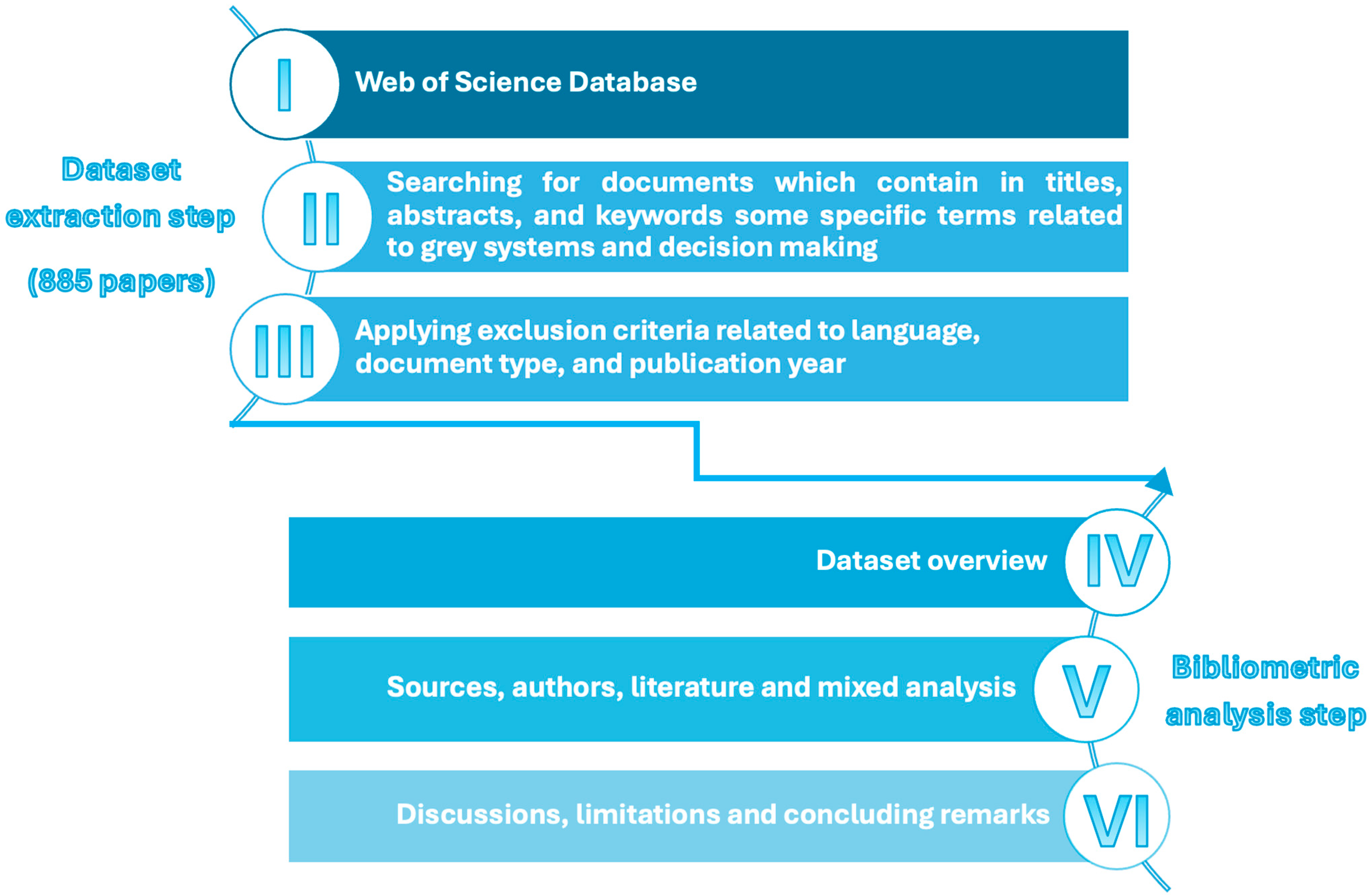

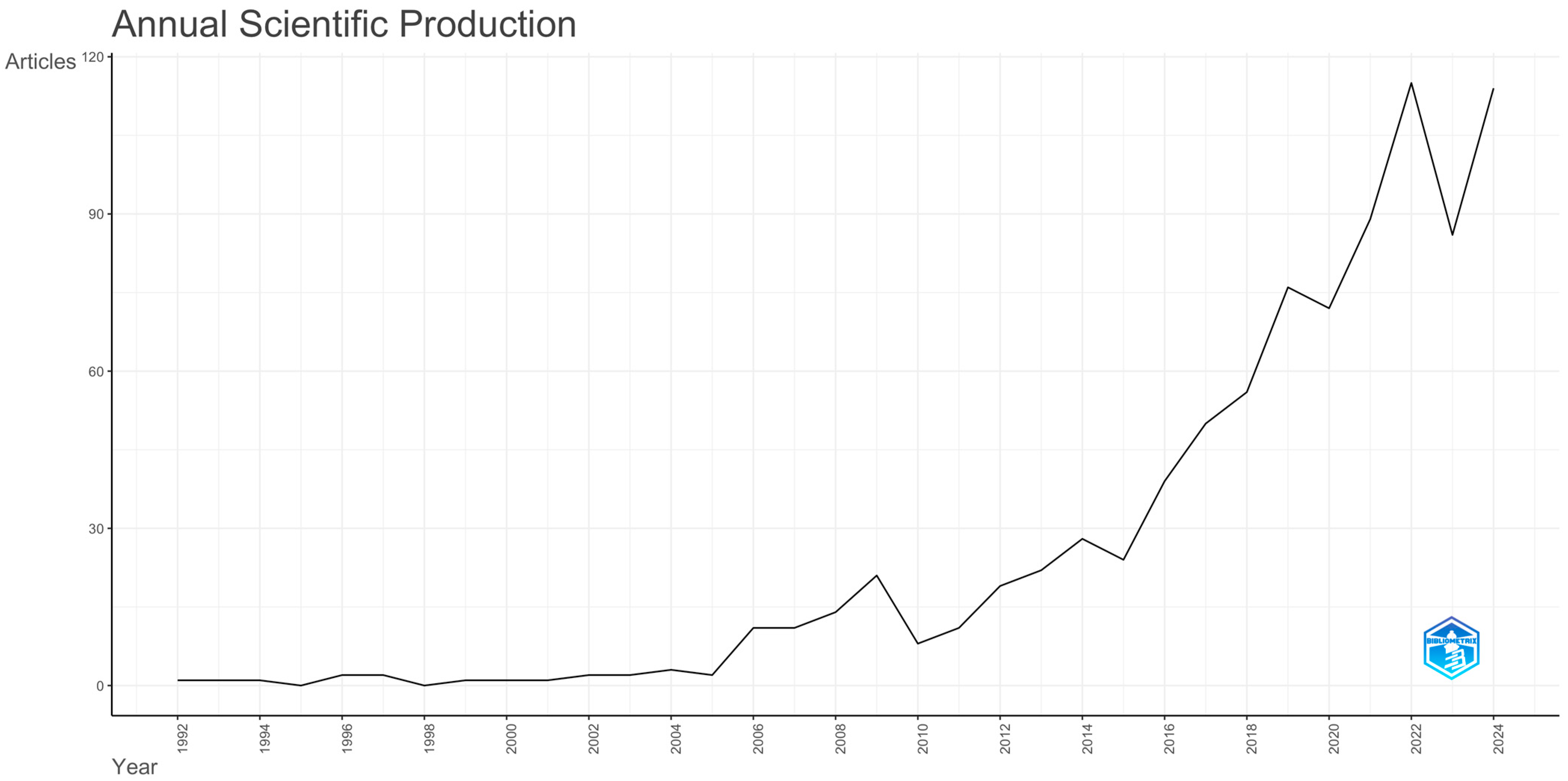
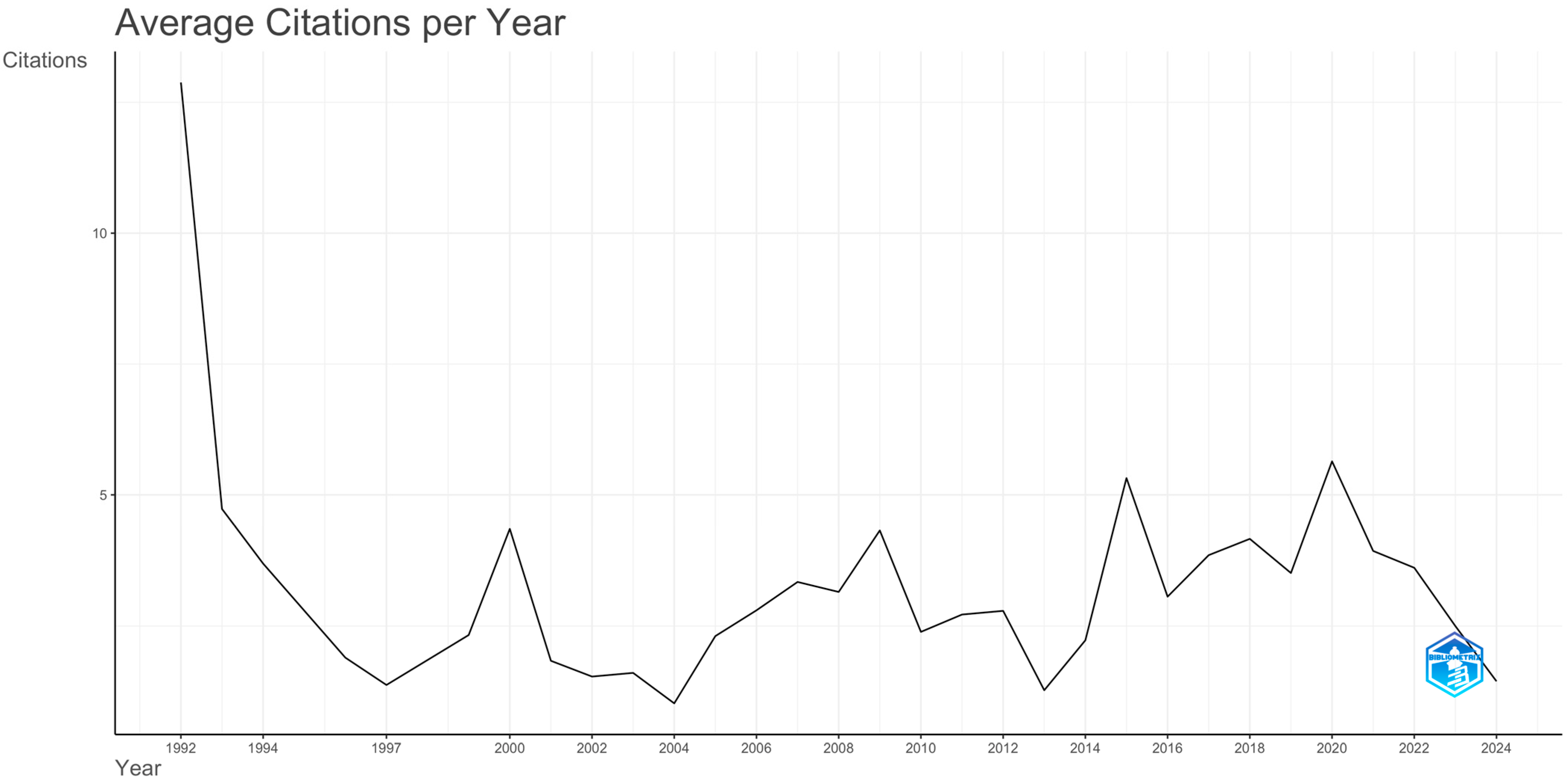
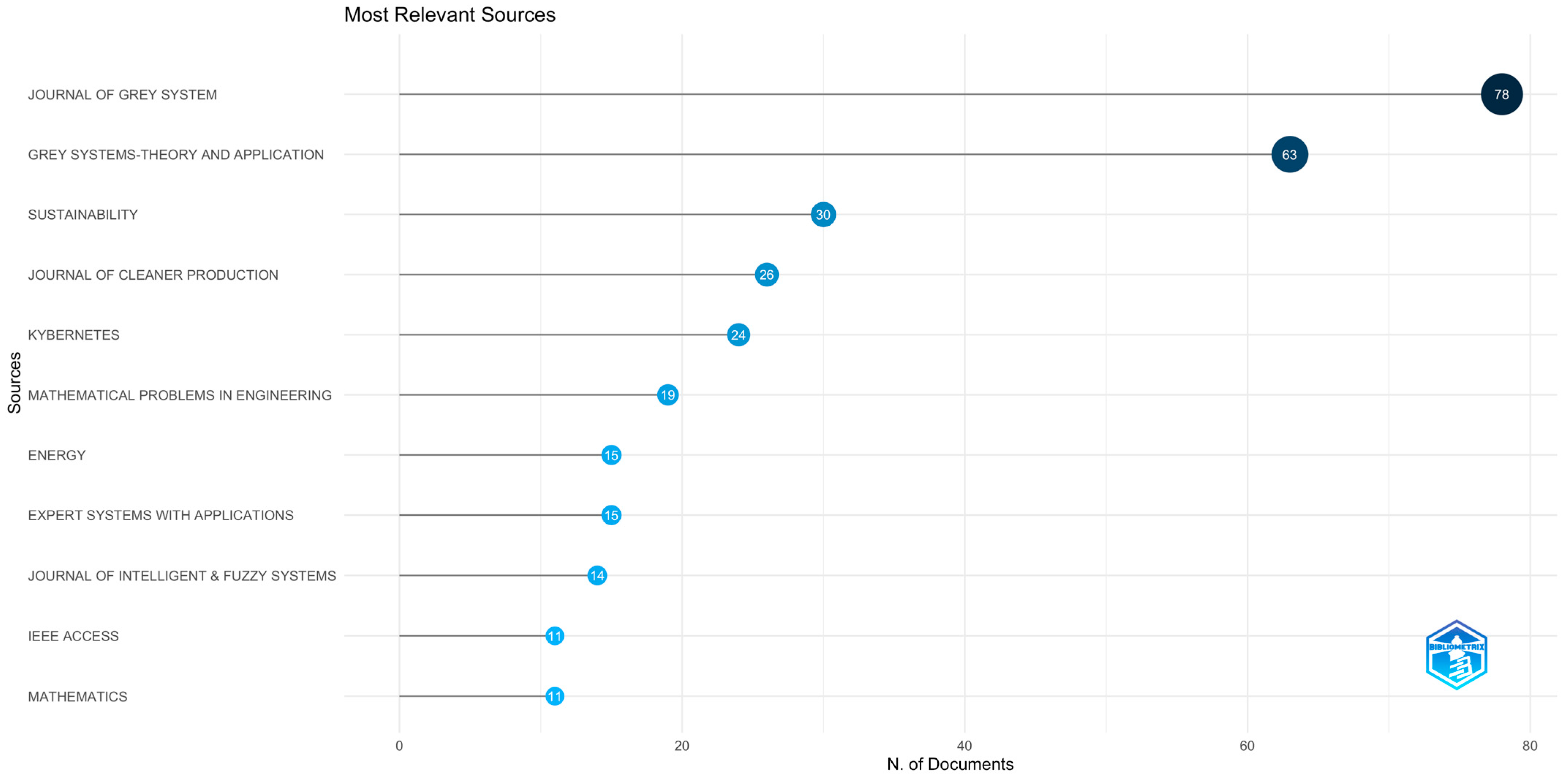
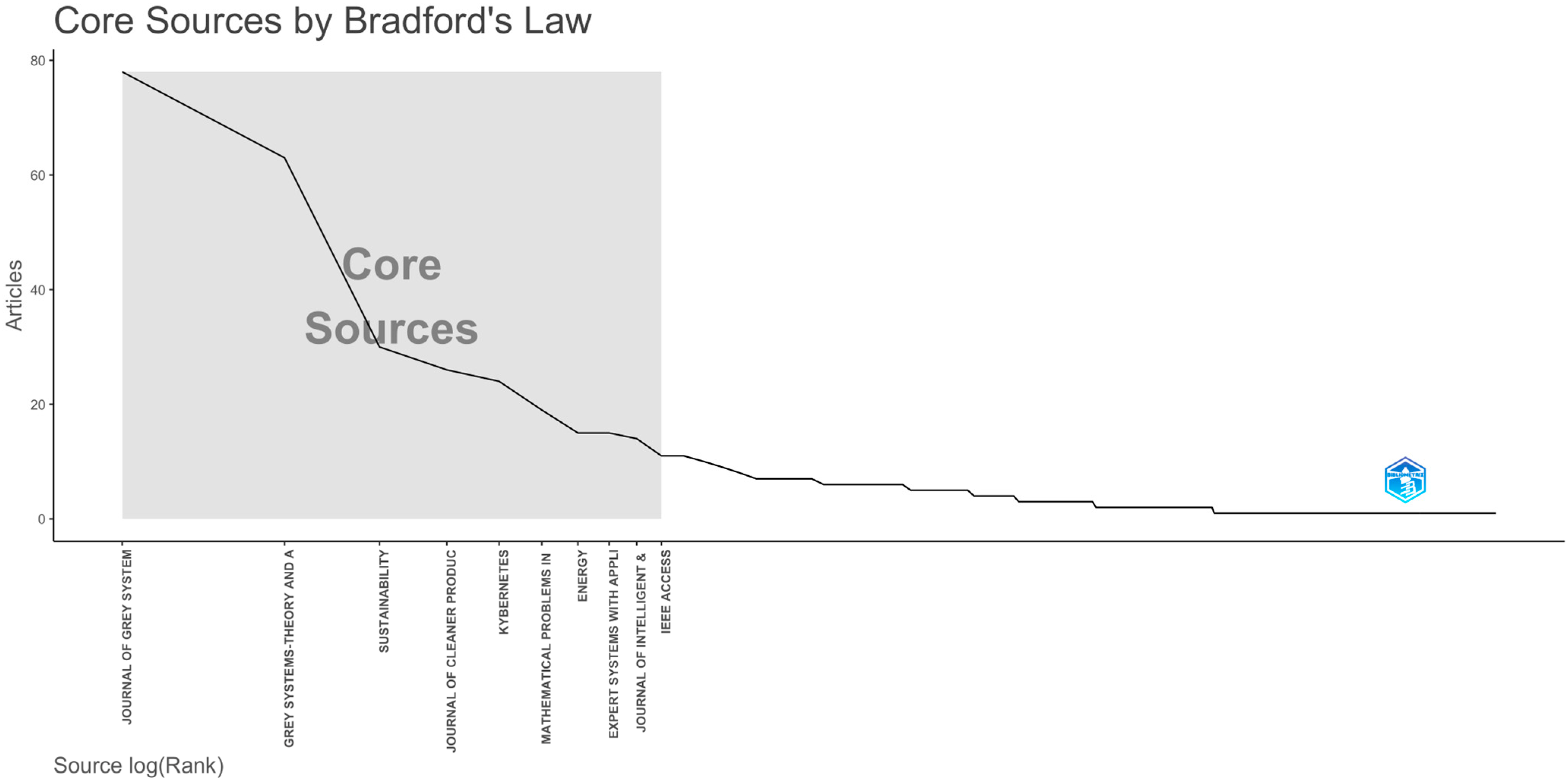
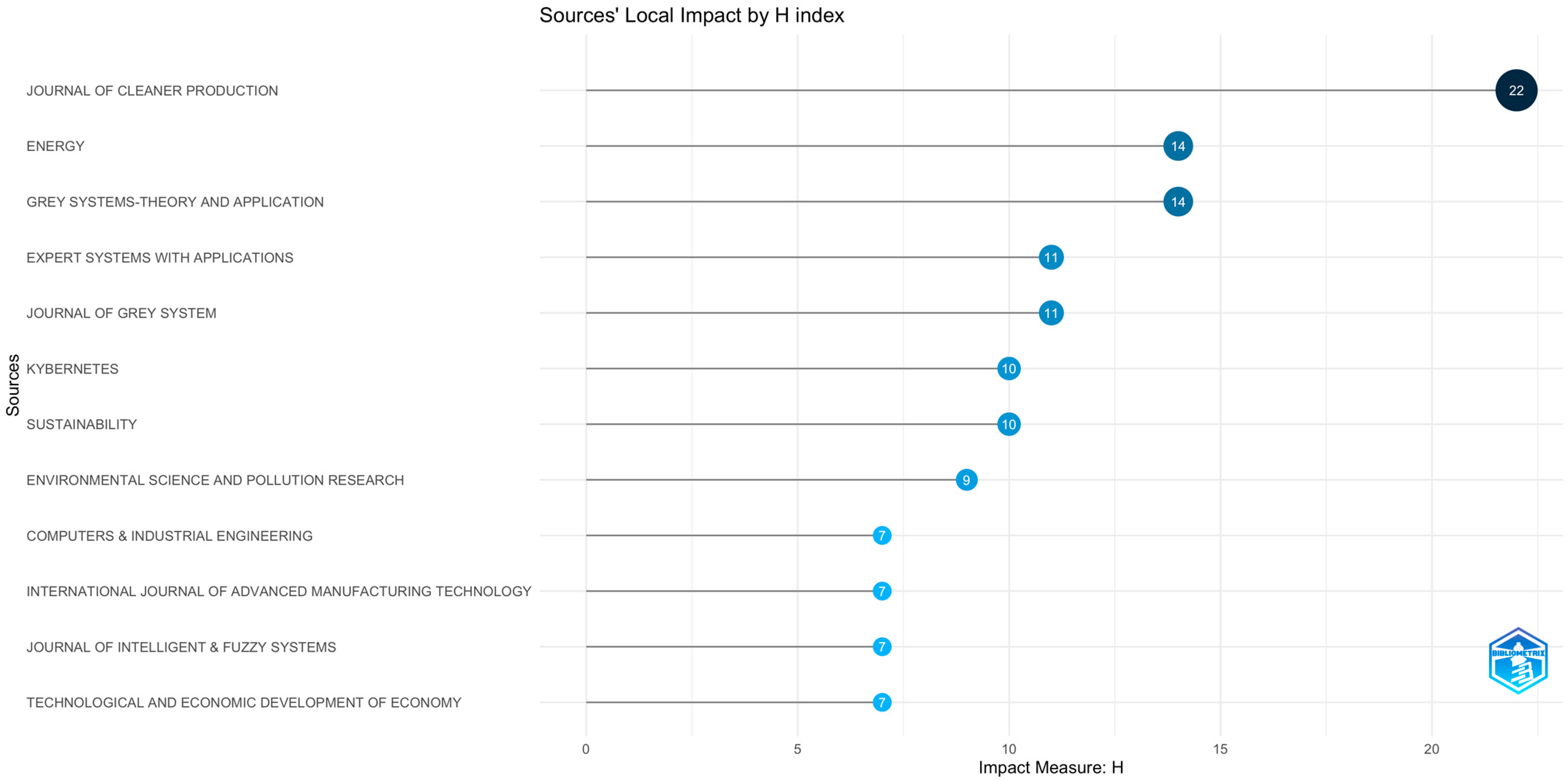

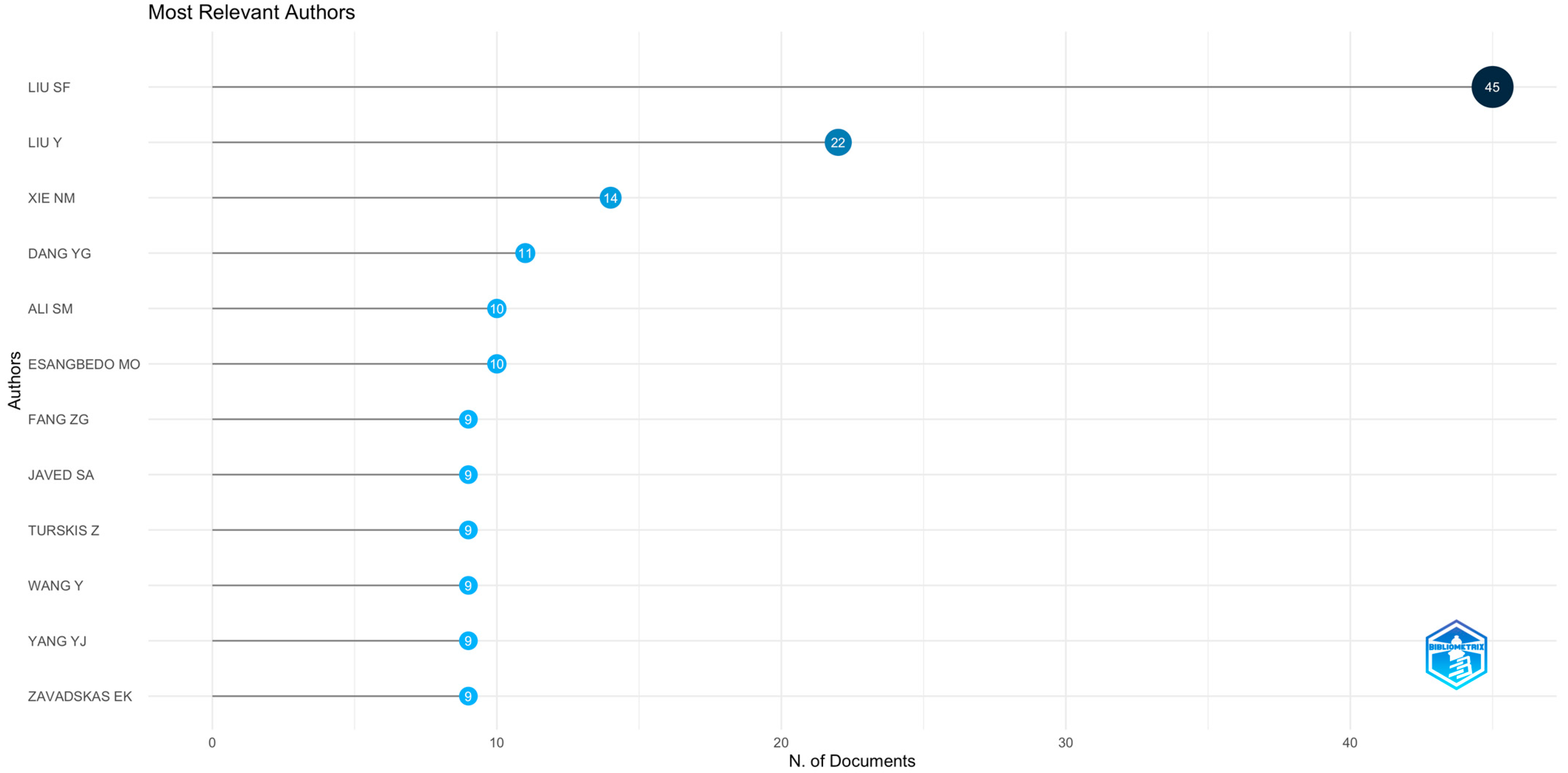
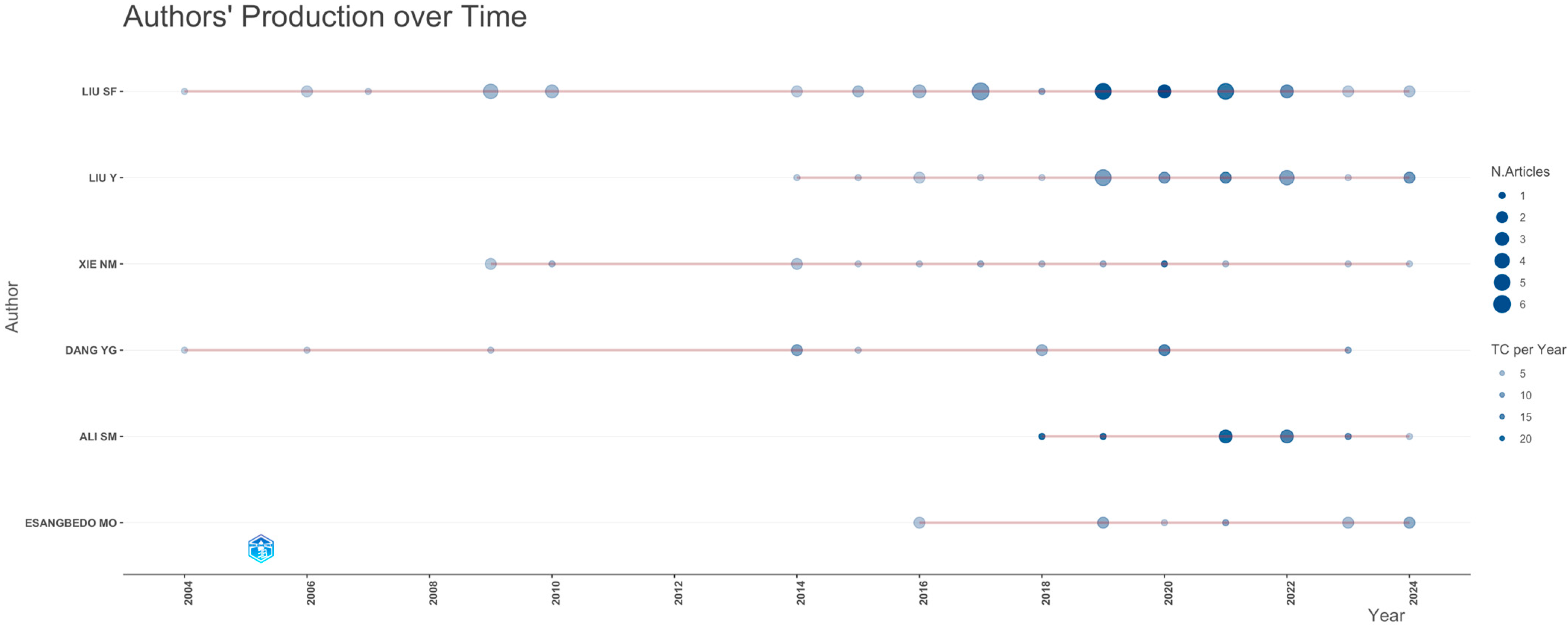
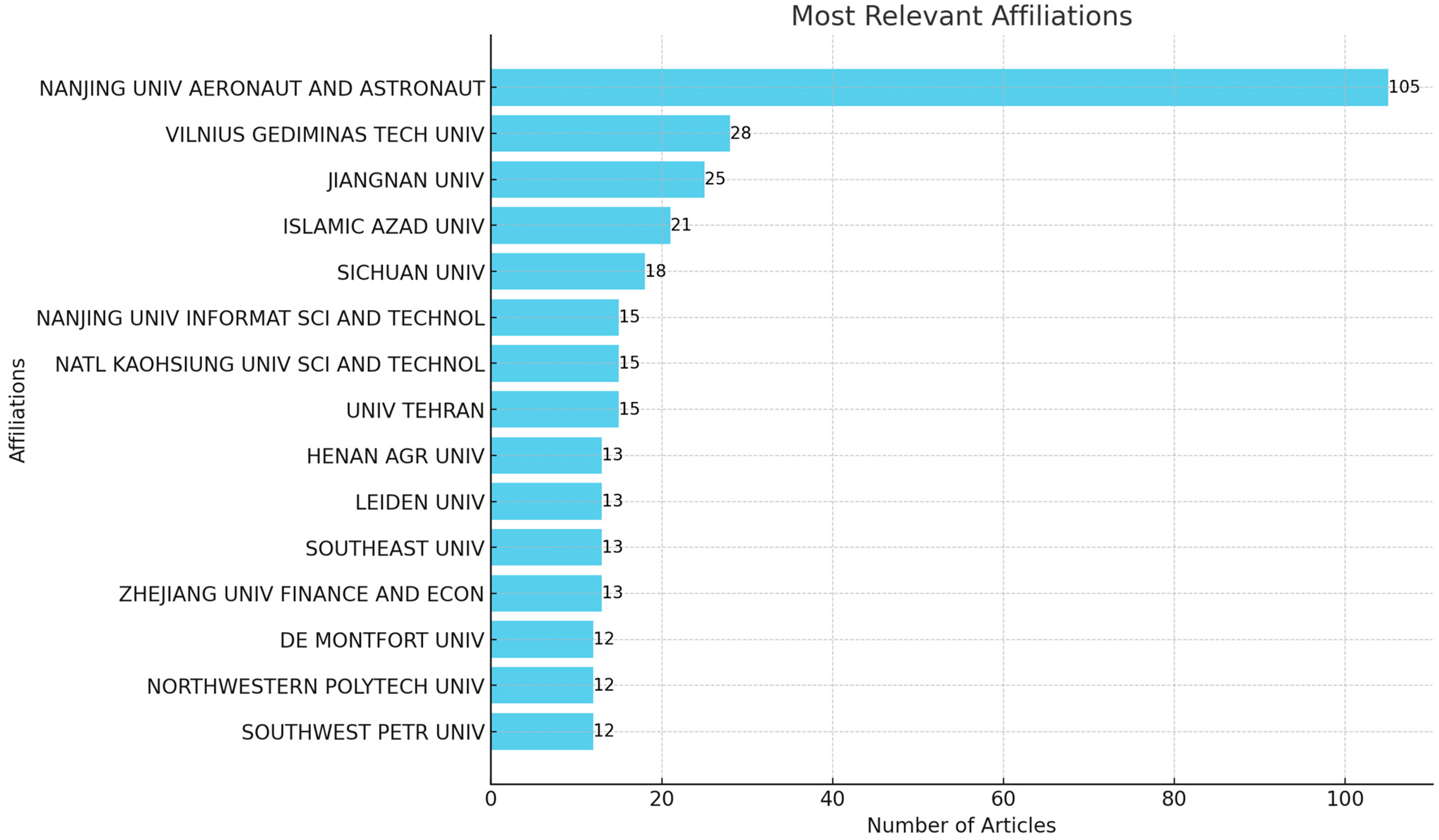




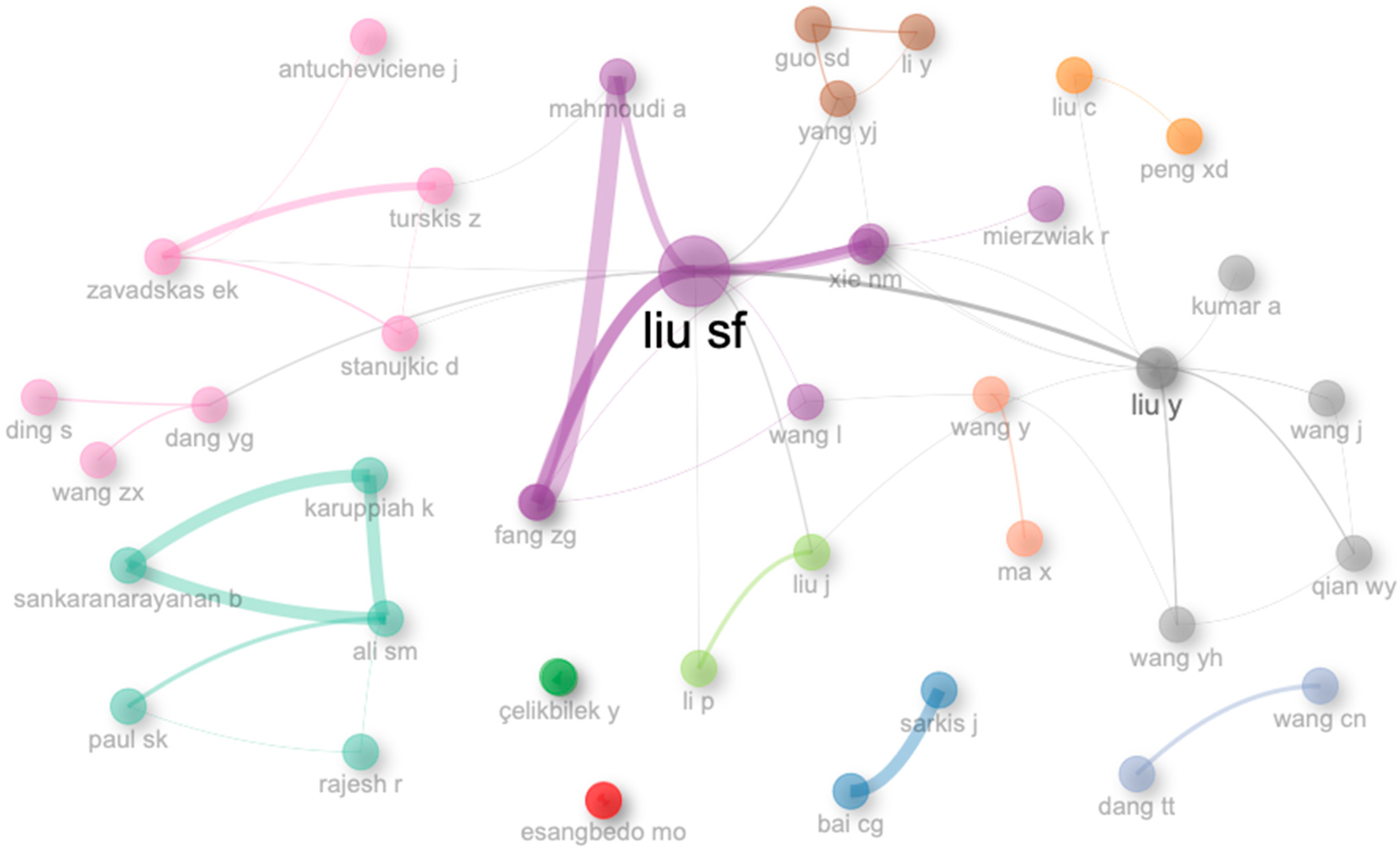
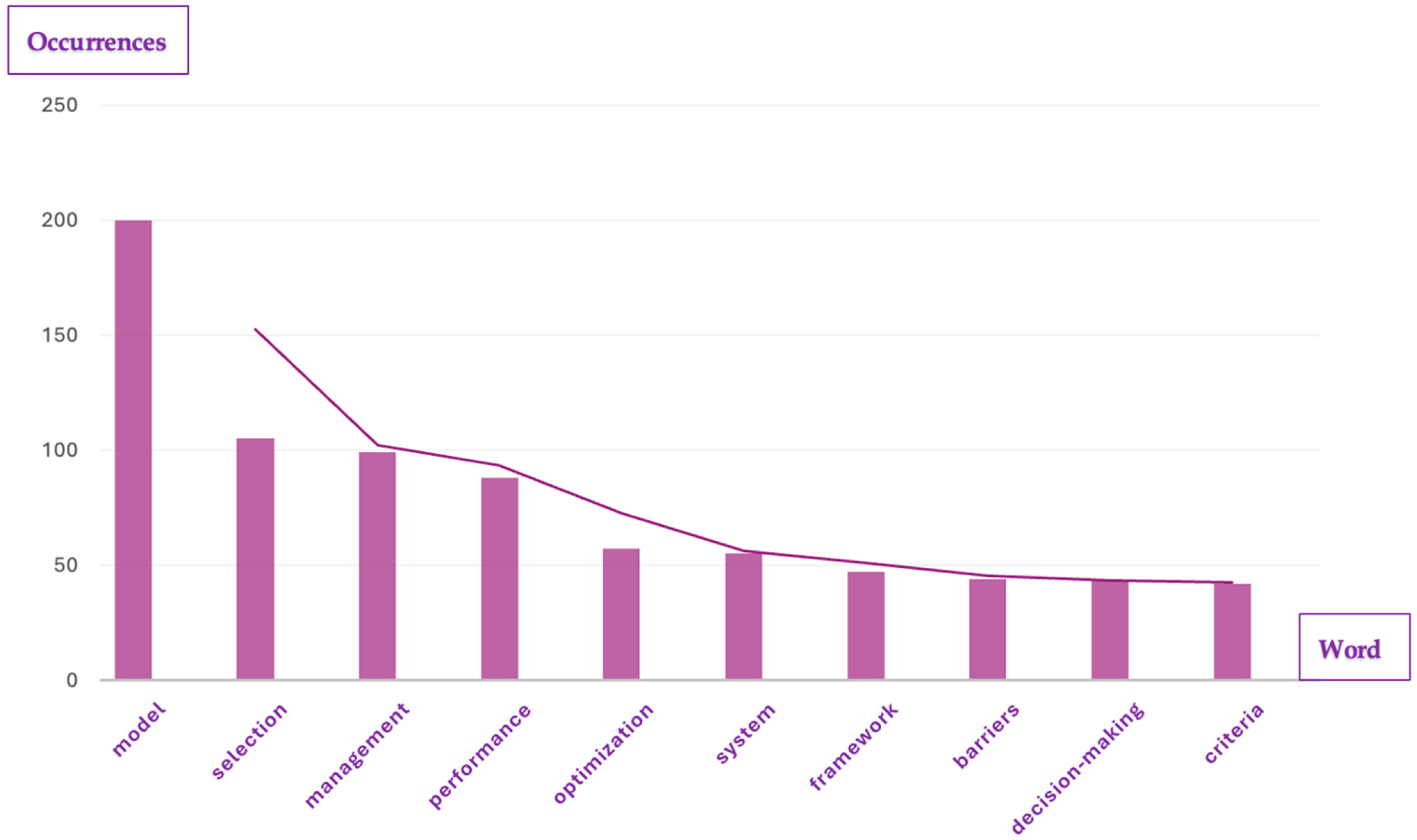

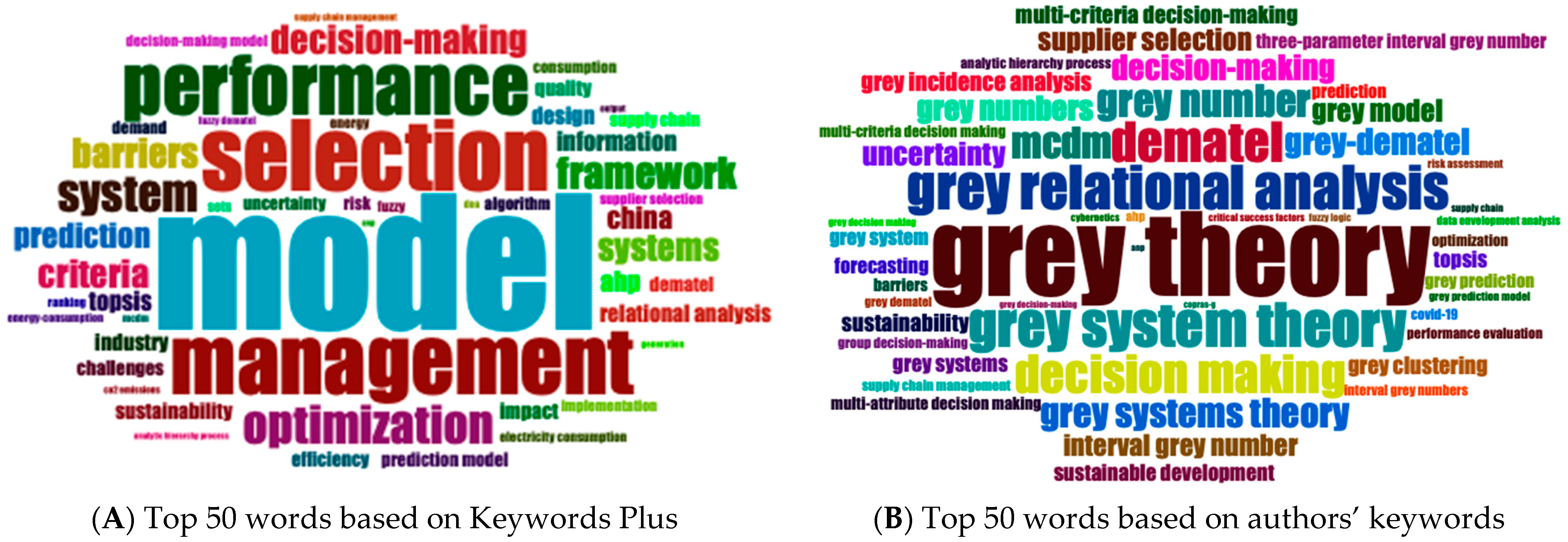
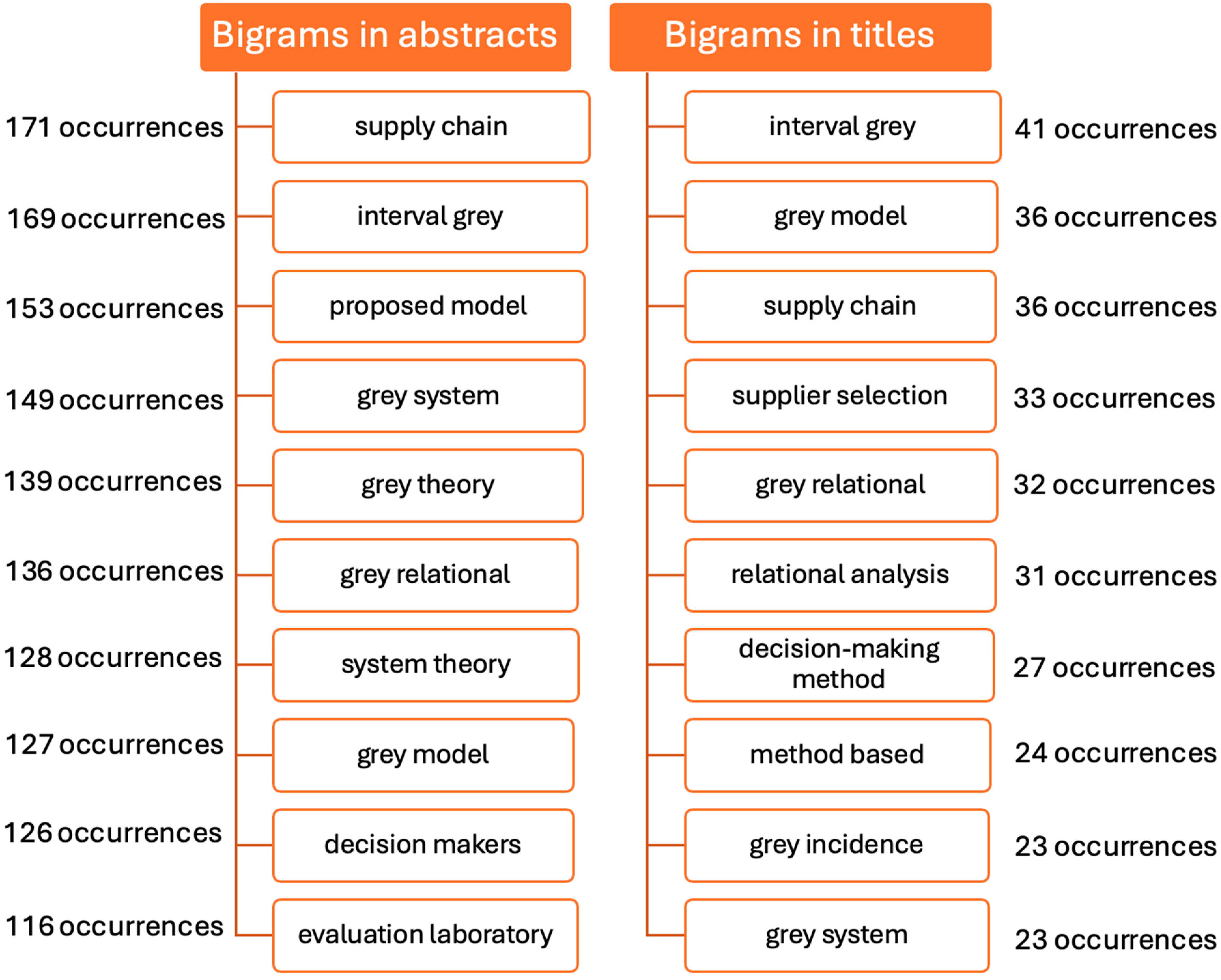
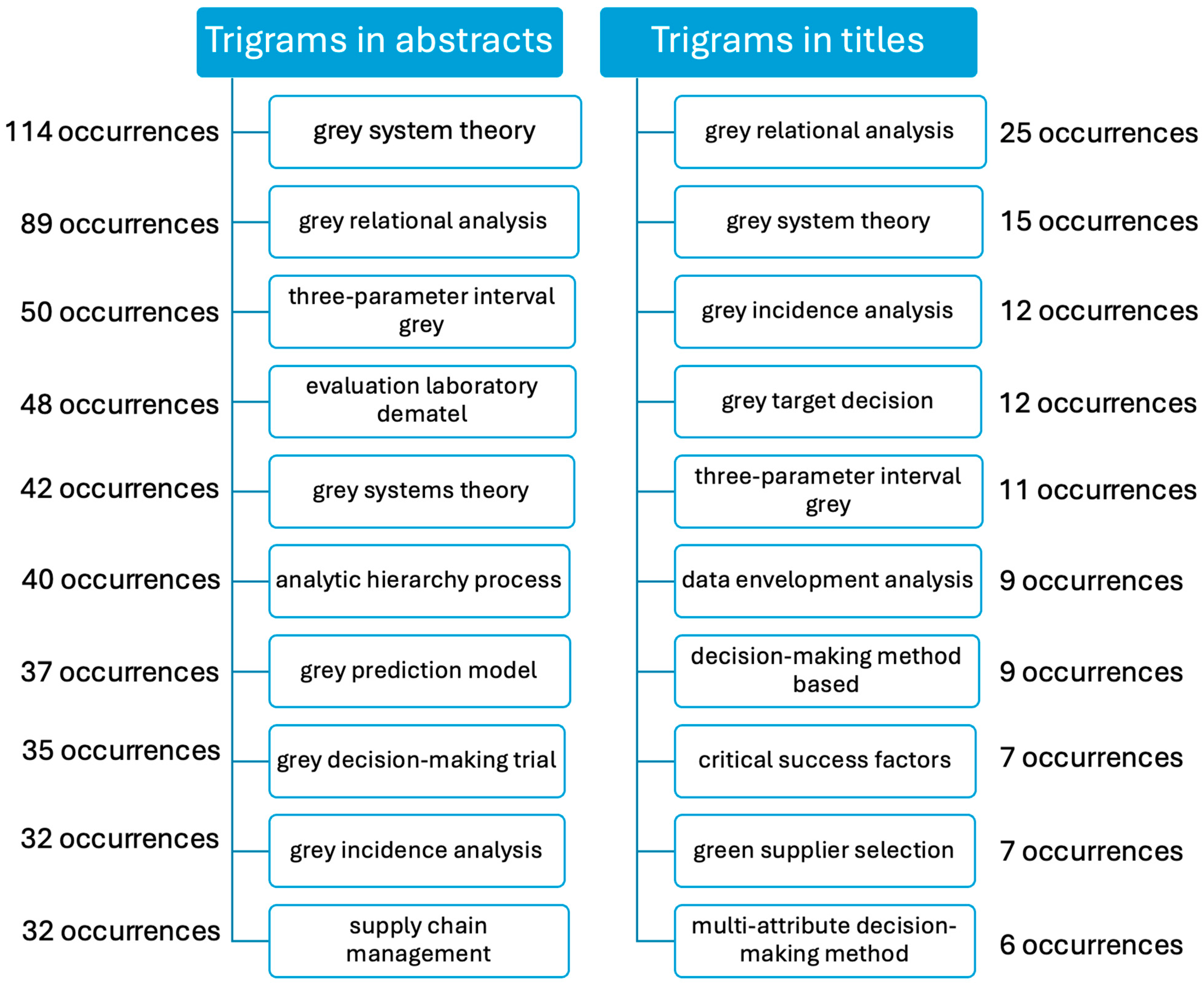

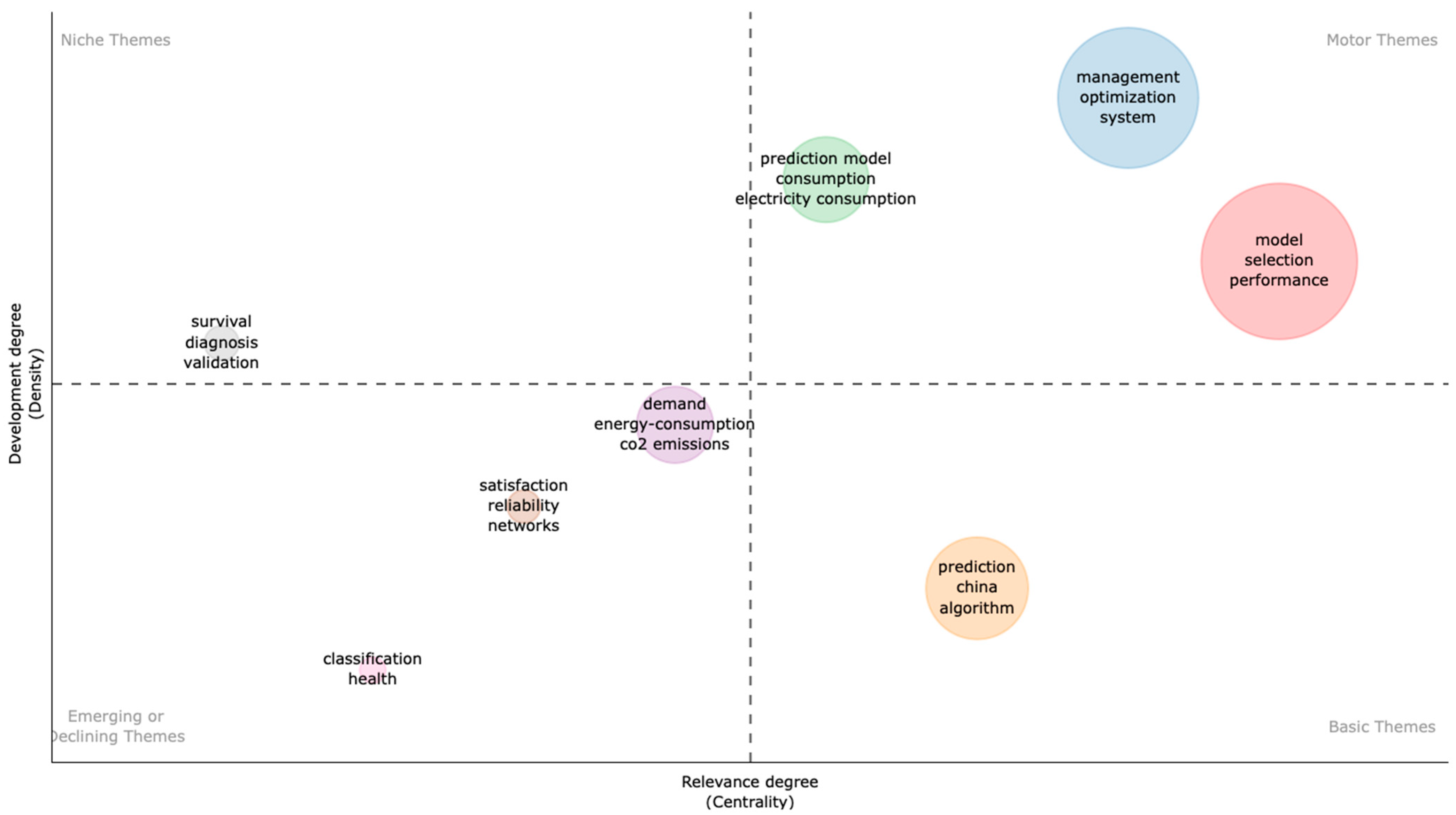
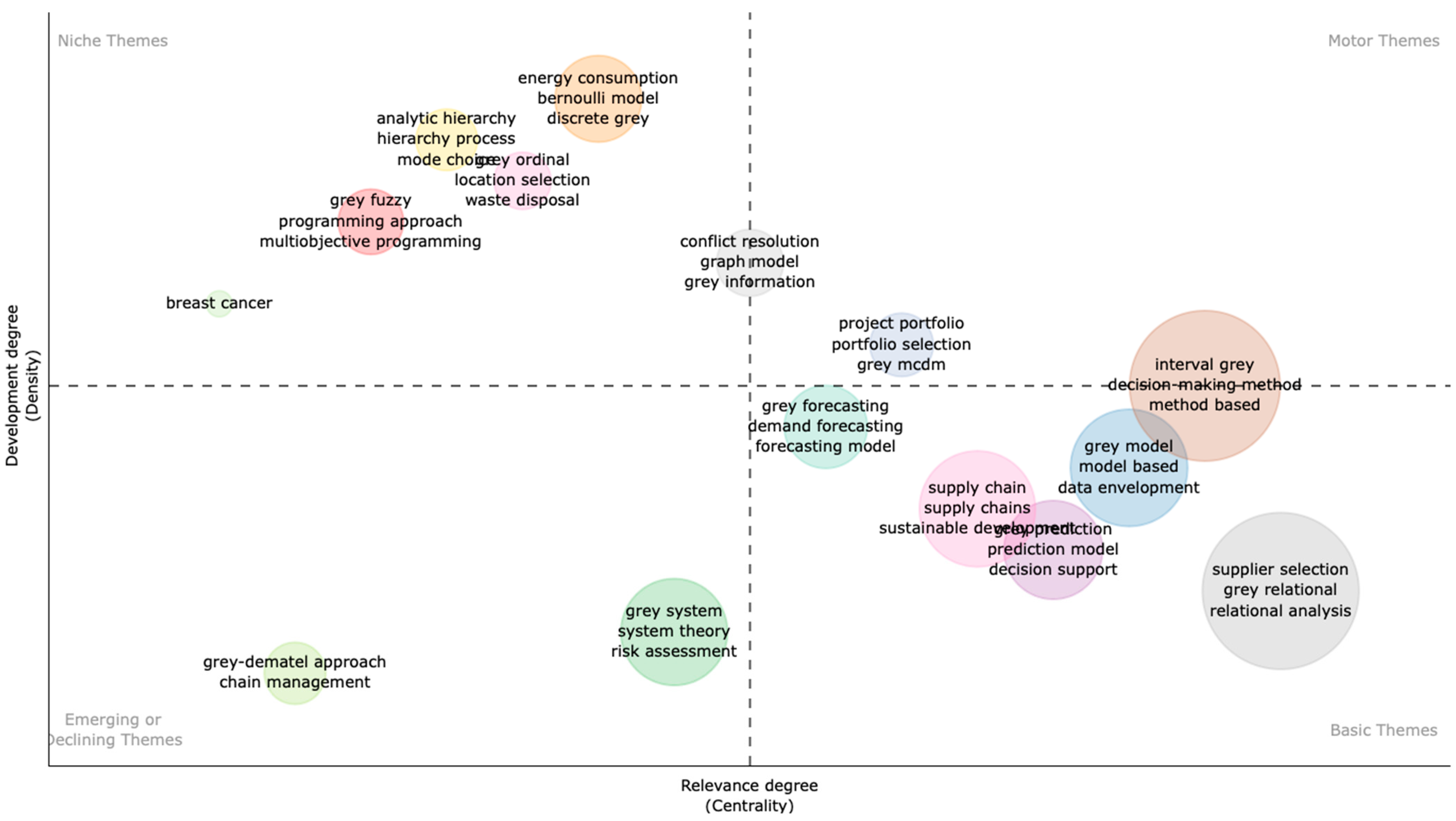

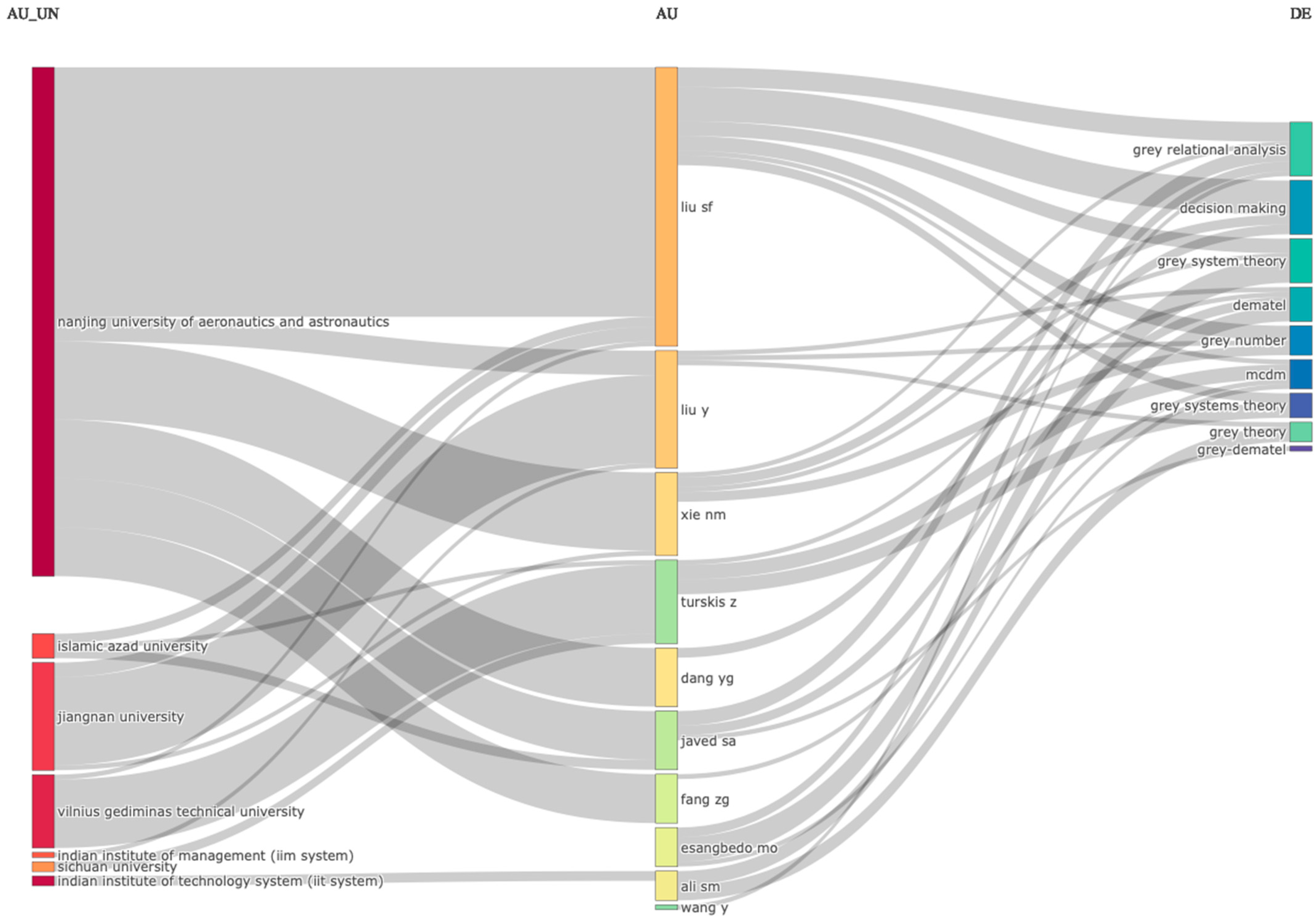
| Reference | Database | Software | Focus |
|---|---|---|---|
| Tao et al. [45] | WoS | CiteSpace | Grey systems theory in engineering. |
| Jiang et al. [46] | WoS | CiteSpace | Grey systems theory in supply chain. |
| Delcea and Cotfas [43] | WoS | Biblioshiny | Grey systems theory in economics and social sciences. |
| Delcea et al. [44] | WoS | Biblioshiny | Grey systems theory in economics and education. |
| Domenteanu et al. [17] | WoS | Biblioshiny | Grey systems theory in uncertain environments. |
| Delcea and Cotfas [1] | WoS | Biblioshiny | Grey systems theory in supplier selection. |
| Exploration Steps | Questions on WoS | Description | Query | Query Number | Count |
|---|---|---|---|---|---|
| 1 | Title | Contains one of the grey systems-specific keywords a | (((((((((TI=(“grey_system*”)) OR TI=(“grey_number*”)) OR TI=(“grey_cluster*”)) OR TI=(“grey_control*”)) OR TI=(“grey_decision*”)) OR TI=(“grey_incidence*”)) OR TI=(“grey_model*”)) OR TI=(“grey_theor*”)) OR TI=(“grey_sequence*”)) OR TI=(“grey_prediction*”) | #1 | 3081 |
| Contains one of the grey systems-specific keywords b | (((((((((TI=(“gray_system*”)) OR TI=(“gray_number*”)) OR TI=(“gray_cluster*”)) OR TI=(“gray_control*”)) OR TI=(“gray_decision*”)) OR TI=(“gray_incidence*”)) OR TI=(“gray_model*”)) OR TI=(“gray_theor*”)) OR TI=(“gray_sequence*”)) OR TI=(“gray_prediction*”) | #2 | 483 | ||
| 2 | Abstract | Contains one of the grey systems-specific keywords a | (((((((((AB=(“grey_system*”)) OR AB=(“grey_number*”)) OR AB=(“grey_cluster*”)) OR AB=(“grey_control*”)) OR AB=(“grey_decision*”)) OR AB=(“grey_incidence*”)) OR AB=(“grey_model*”)) OR AB=(“grey_theor*”)) OR AB=(“grey_sequence*”)) OR AB=(“grey_prediction*”) | #3 | 6761 |
| Contains one of the grey systems-specific keywords b | (((((((((AB=(“gray_system*”)) OR AB=(“gray_number*”)) OR AB=(“gray_cluster*”)) OR AB=(“gray_control*”)) OR AB=(“gray_decision*”)) OR AB=(“gray_incidence*”)) OR AB=(“gray_model*”)) OR AB=(“gray_theor*”)) OR AB=(“gray_sequence*”)) OR AB=(“gray_prediction*”) | #4 | 2288 | ||
| 3 | Keywords | Contains one of the grey systems-specific keywords a | (((((((((AK=(“grey_system*”)) OR AK=(“grey_number*”)) OR AK=(“grey_cluster*”)) OR AK=(“grey_control*”)) OR AK=(“grey_decision*”)) OR AK=(“grey_incidence*”)) OR AK=(“grey_model*”)) OR AK=(“grey_theor*”)) OR AK=(“grey_sequence*”)) OR AK=(“grey_prediction*”) | #5 | 4526 |
| Contains one of the grey systems-specific keywords b | (((((((((AK=(“gray_system*”)) OR AK=(“gray_number*”)) OR AK=(“gray_cluster*”)) OR AK=(“gray_control*”)) OR AK=(“gray_decision*”)) OR AK=(“gray_incidence*”)) OR AK=(“gray_model*”)) OR AK=(“gray_theor*”)) OR AK=(“gray_sequence*”)) OR AK=(“gray_prediction*”) | #6 | 778 | ||
| 4 | Title/Abstract/Keywords | Contains one of the grey systems-specific keywords | #1 OR #2 OR #3 OR #4 OR #5 OR #6 | #7 | 10,278 |
| Contains specific words related to decision-making | ((TI=(decision_mak*)) OR AB=(decision_mak*)) OR AK=(decision_mak*) | #8 | 649,586 | ||
| Contains keywords related to grey systems and decision-making | #7 AND #8 | #9 | 1246 | ||
| 5 | Language | Contains papers in English | (#9) AND LA=(English) | #10 | 1233 |
| 6 | Type of paper | Include only documents marked as “article” by WoS | (#10) AND DT=(Article) | #11 | 898 |
| 6 | Publication year | Exclude 2025 | (#11) NOT PY=2025 | #12 | 885 |
| No. | Paper (First Author, Year, Journal, Reference) | Title | Methods Used | Data | Purpose |
|---|---|---|---|---|---|
| 1 | Raj A, 2020, International Journal of Production Economics, [81] | Barriers to the adoption of Industry 4.0 technologies in the manufacturing sector: An inter-country comparative perspective | Grey Decision-Making Trial Evaluation Laboratory (DEMATEL) | Data from experts’ responses and from different sources. | Provides an overview of the difficulties encountered in the adoption of Industry 4.0 technologies, focusing especially on the domain of manufacturing. |
| 2 | Wolbers M, 2009, Epidemiology, [82] | Prognostic Models with Competing Risks Methods and Application to Coronary Risk Prediction | Fine and Gray model. Cause-specific hazards model. Standard Cox model. | Data was gathered from the Rotterdam Study, consisting of medical information about 4144 women, between 55 and 90 years old, who did not have CHD at the beginning of the study. | Understand and predict how different factors can influence the apparition of coronary heart disease (CHD) in the case of older women. |
| 3 | Huang GH, 2007, Civil Engineering Systems, [83] | A grey linear programming approach for municipal solid waste management planning under uncertainty | Grey Linear Programming (GLP). Simplex algorithm. | Hypothetical data for three municipalities. | Offer a novel grey linear programming model (GLP) for dealing with uncertainty in the domain of management planning associated with municipal solid waste. |
| 4 | Hashemi SH, 2015, International Journal of Production Economics, [84] | An integrated green supplier selection approach with an analytic network process and improved grey relational analysis | Analytic network process (ANP). Grey relational analysis (GRA). | A case study about the automotive industry and opinions from experts. | Develop a model for green supplier selection making use of both ANP and GRA, taking into account more factors (economic, environmental). |
| 5 | Tosun N, 2006, The International Journal of Advanced Manufacturing Technology, [79] | Determination of optimum parameters for multi-performance characteristics in drilling by using grey relational analysis | Grey relational analysis (GRA). Taguchi method. | Experiments were performed on the Tezsan M35ES drilling machine, using multiple tool materials. | Optimize the drilling process by making use of grey relational analysis, considering various factors. |
| 6 | Xia XQ, 2015, Journal of Cleaner Production, [85] | Analyzing internal barriers for automotive parts remanufacturers in China using the grey-DEMATEL approach | Grey Decision-Making Trial and Evaluation Laboratory (DEMATEL). | Internal barriers for remanufacture, after discussing with experts and industrial managers. | Identify and analyze using grey DEMATEL the internal barriers for remanufacturing in the domain of automotive, with an emphasis on China. |
| 7 | Li GD, 2007, Mathematical and Computer Modelling, [10] | A grey-based decision-making approach to the supplier selection problem | Grey theory. Grey relational analysis (GRA). Grey possibility degree. Multiple attribute decision-making (MADM). Normalization. | Simulated data related to six suppliers. | Combat the challenge associated with the selection of suppliers under uncertainty, by proposing a grey-based decision-making approach. |
| 8 | Tseng ML, 2009, Expert Systems with Applications, [80] | A causal and effect decision-making model of service quality expectation using a grey-fuzzy DEMATEL approach | Grey-fuzzy DEMATEL. | The answer of 280 customers to a survey with 21 questions. | Identify the factors that influence the service quality, employing the use of grey-fuzzy DEMATEL for customers’ satisfaction, in the real estate domain. |
| 9 | Zavadskas EK, 2008, Journal of Civil Engineering & Management, [86] | Selection of the effective dwelling house walls by applying attribute values determined at intervals | Grey theory. Complex Proportional assessment of alternatives with grey relations (COPRAS-G). | Data from other research papers. Experts’ opinions. | Addressing the challenges in decision-making processes related to the construction management sector, considering multiple factors. |
| 10 | Özcan T, 2011, Expert Systems with Applications, [87] | Comparative analysis of multi-criteria decision-making methodologies and implementation of a warehouse location selection problem | Analytic hierarchy process (AHP). Techniques for order preference by similarity to ideal solution (TOPSIS). Elimination and choice expressing reality (ELECTRE). Grey Theory | Data about warehouses, and relevant factors for assessing their location selection. | Offering an overview of the AHP, TOPSIS, ELECTRE, and Grey Theory, comparing and assessing them in selecting the best warehouse location, and considering relevant factors. |
Disclaimer/Publisher’s Note: The statements, opinions and data contained in all publications are solely those of the individual author(s) and contributor(s) and not of MDPI and/or the editor(s). MDPI and/or the editor(s) disclaim responsibility for any injury to people or property resulting from any ideas, methods, instructions or products referred to in the content. |
© 2025 by the authors. Licensee MDPI, Basel, Switzerland. This article is an open access article distributed under the terms and conditions of the Creative Commons Attribution (CC BY) license (https://creativecommons.org/licenses/by/4.0/).
Share and Cite
Sandu, A.; Diaconu, P.; Delcea, C.; Domenteanu, A. Emphasizing Grey Systems Contribution to Decision-Making Field Under Uncertainty: A Global Bibliometric Exploration. Mathematics 2025, 13, 1278. https://doi.org/10.3390/math13081278
Sandu A, Diaconu P, Delcea C, Domenteanu A. Emphasizing Grey Systems Contribution to Decision-Making Field Under Uncertainty: A Global Bibliometric Exploration. Mathematics. 2025; 13(8):1278. https://doi.org/10.3390/math13081278
Chicago/Turabian StyleSandu, Andra, Paul Diaconu, Camelia Delcea, and Adrian Domenteanu. 2025. "Emphasizing Grey Systems Contribution to Decision-Making Field Under Uncertainty: A Global Bibliometric Exploration" Mathematics 13, no. 8: 1278. https://doi.org/10.3390/math13081278
APA StyleSandu, A., Diaconu, P., Delcea, C., & Domenteanu, A. (2025). Emphasizing Grey Systems Contribution to Decision-Making Field Under Uncertainty: A Global Bibliometric Exploration. Mathematics, 13(8), 1278. https://doi.org/10.3390/math13081278








